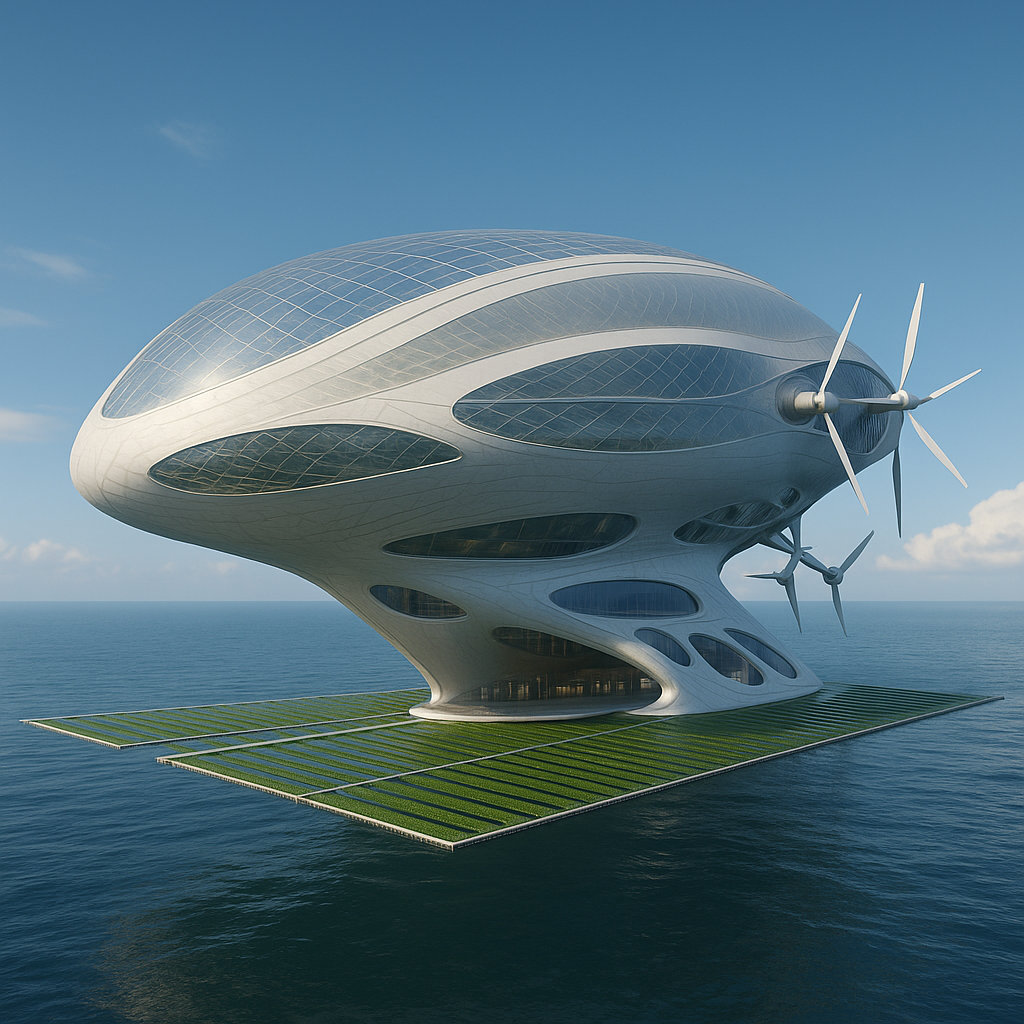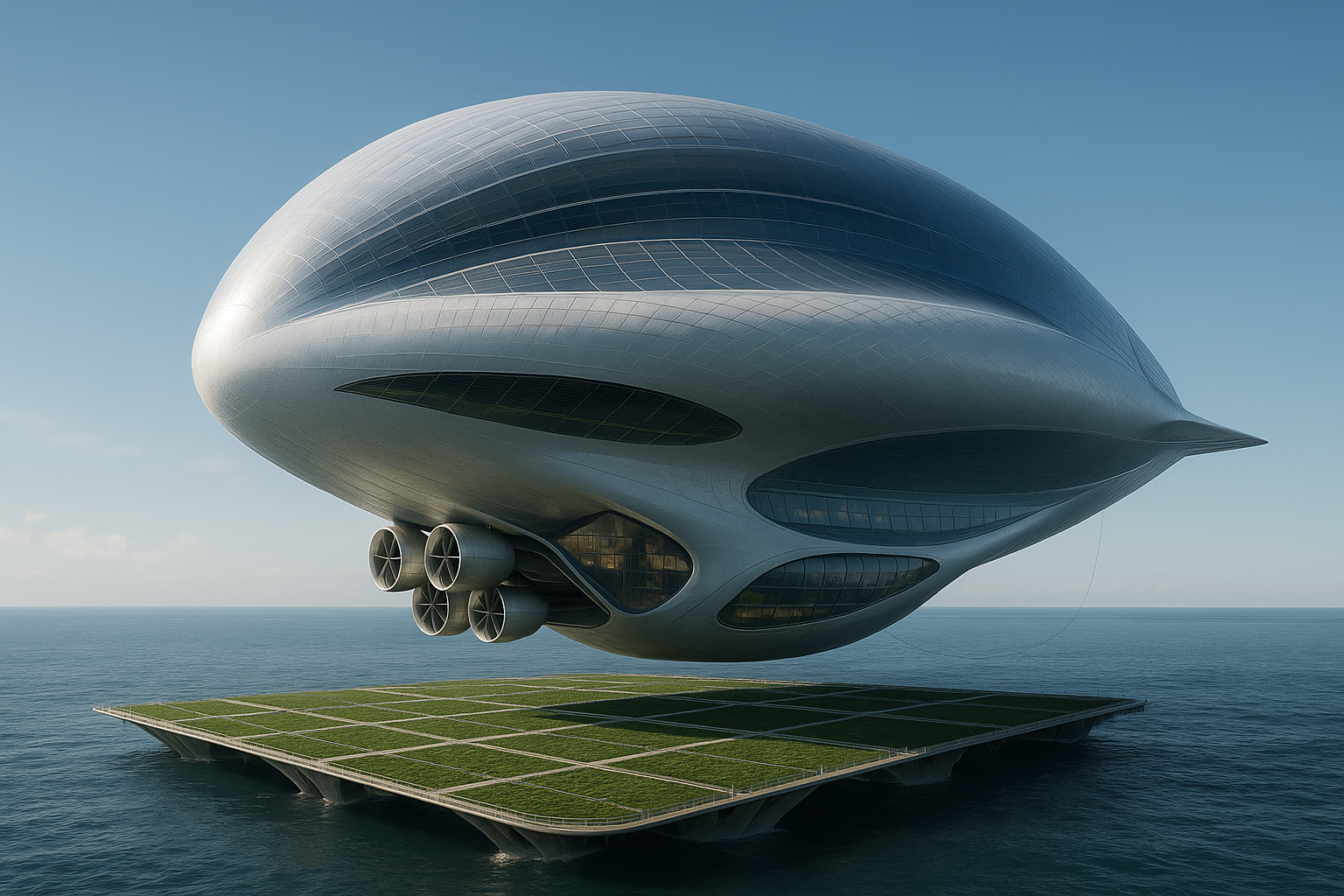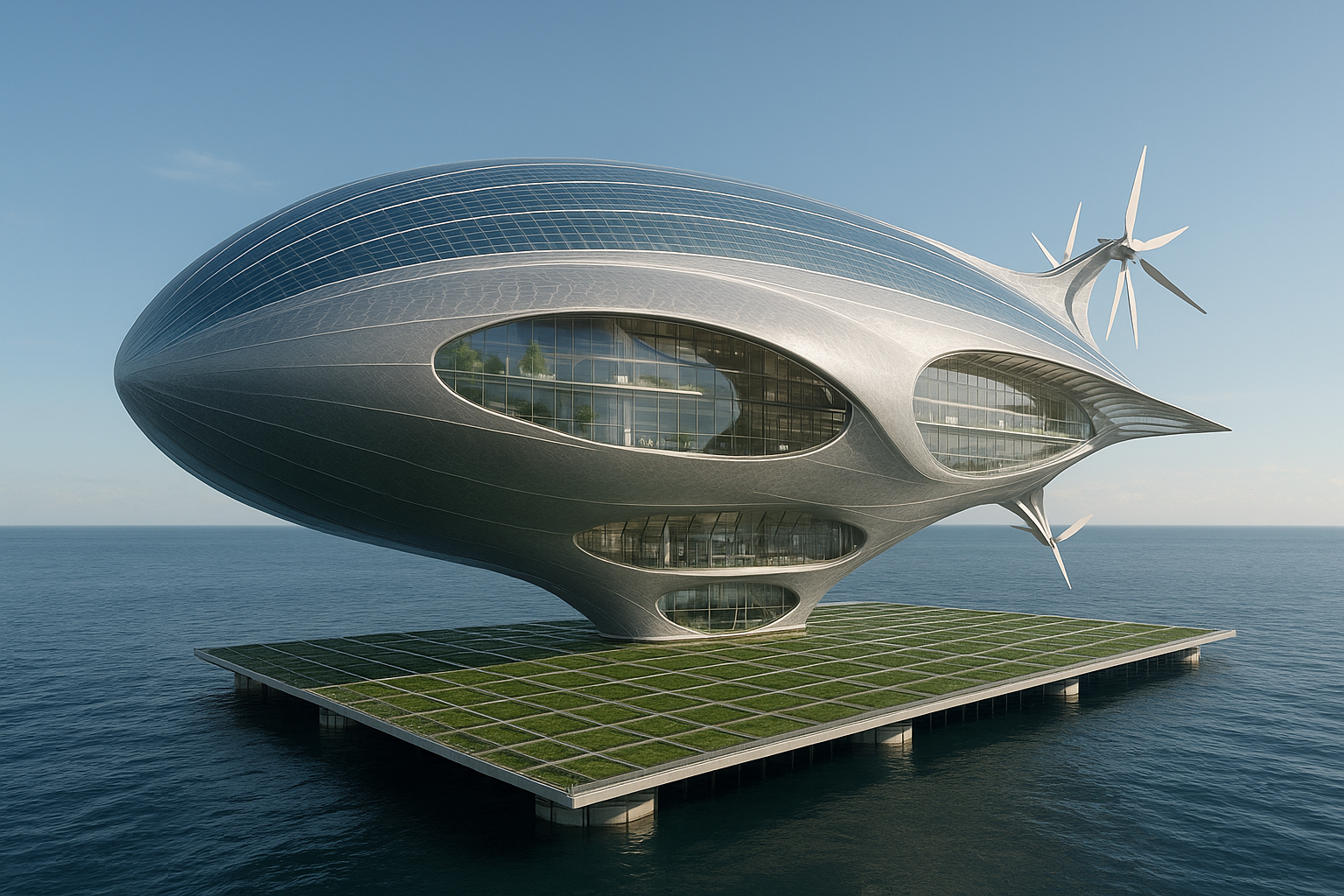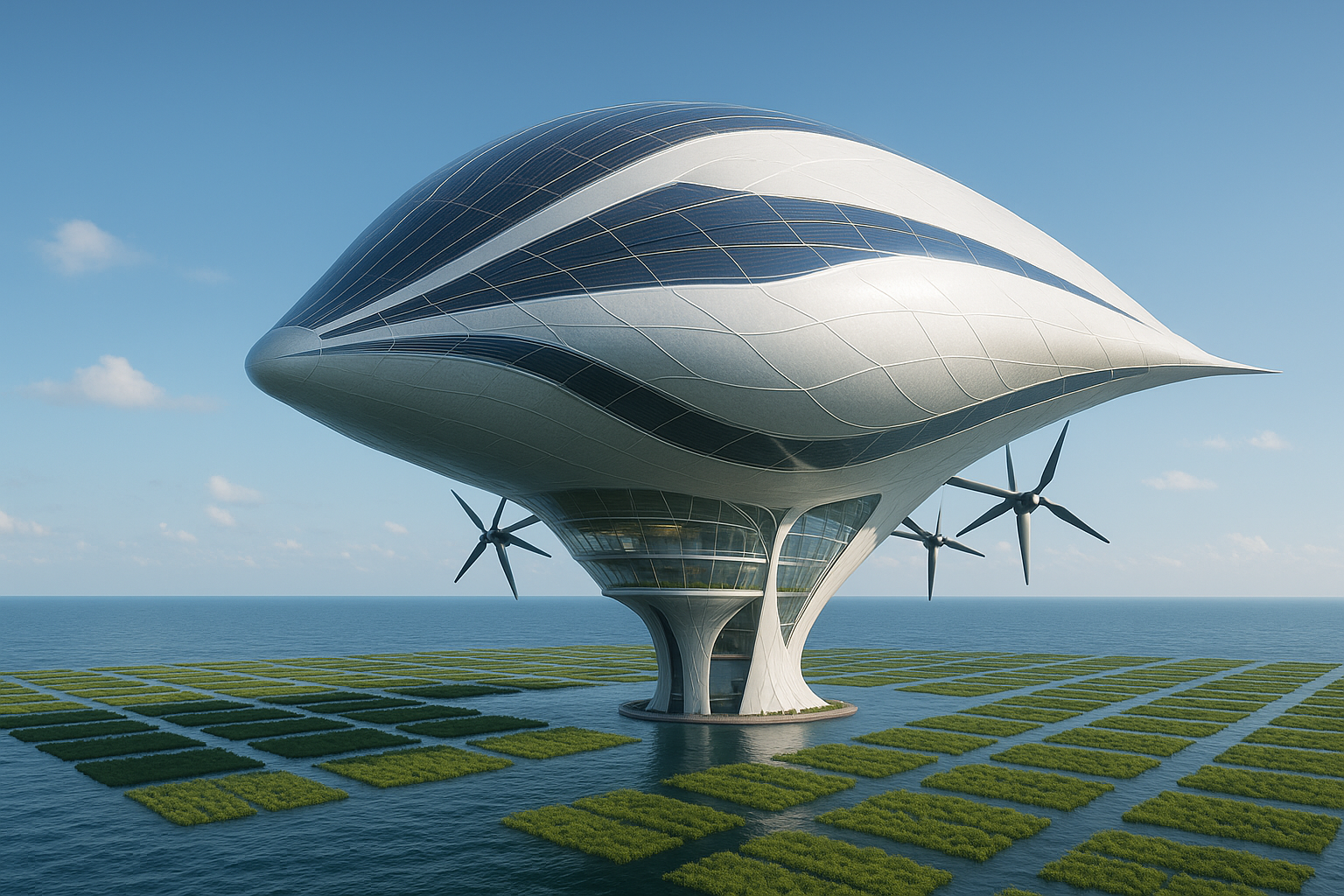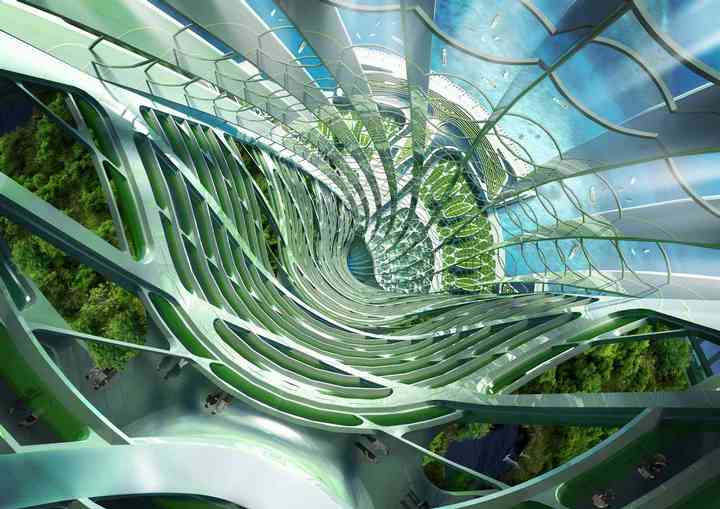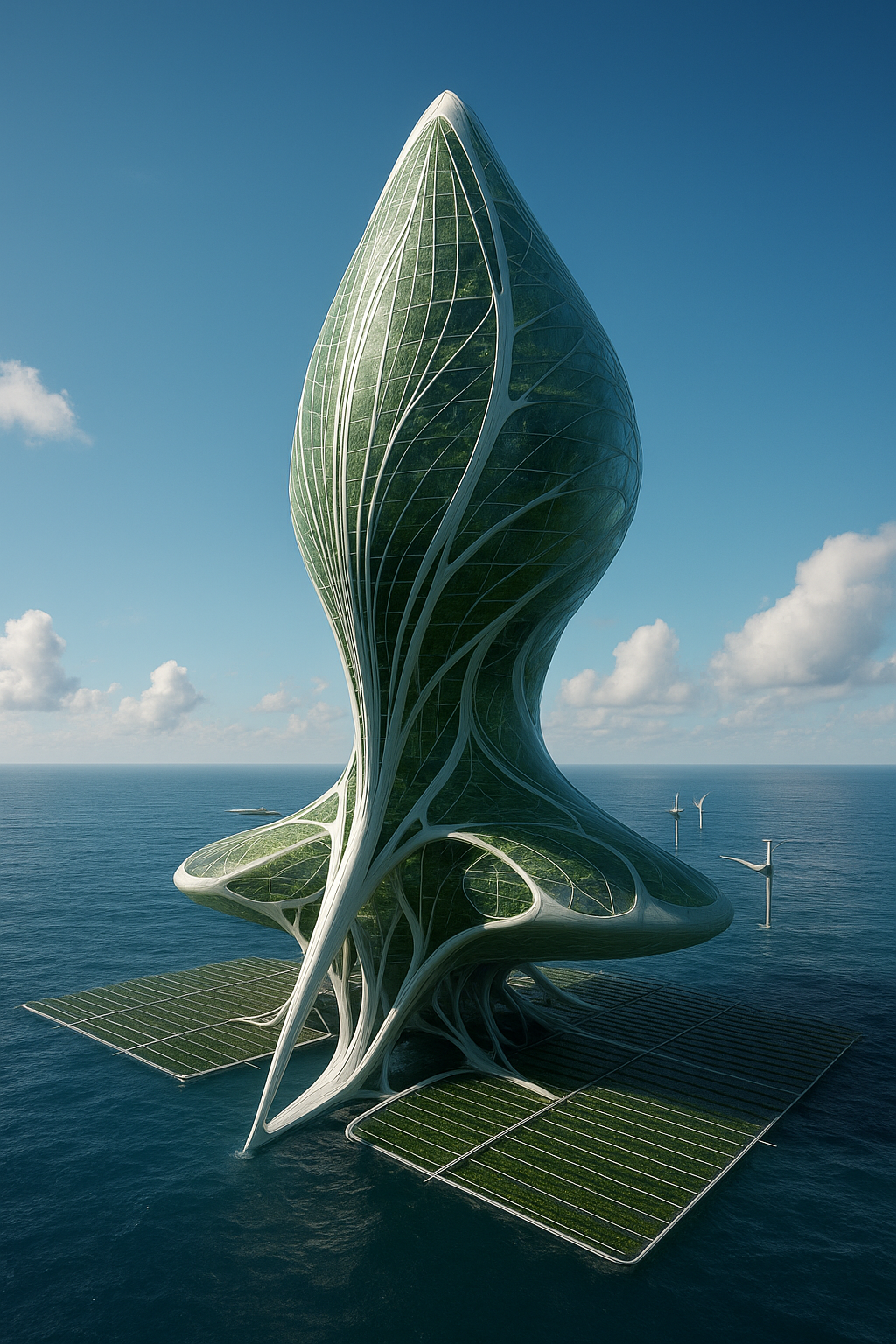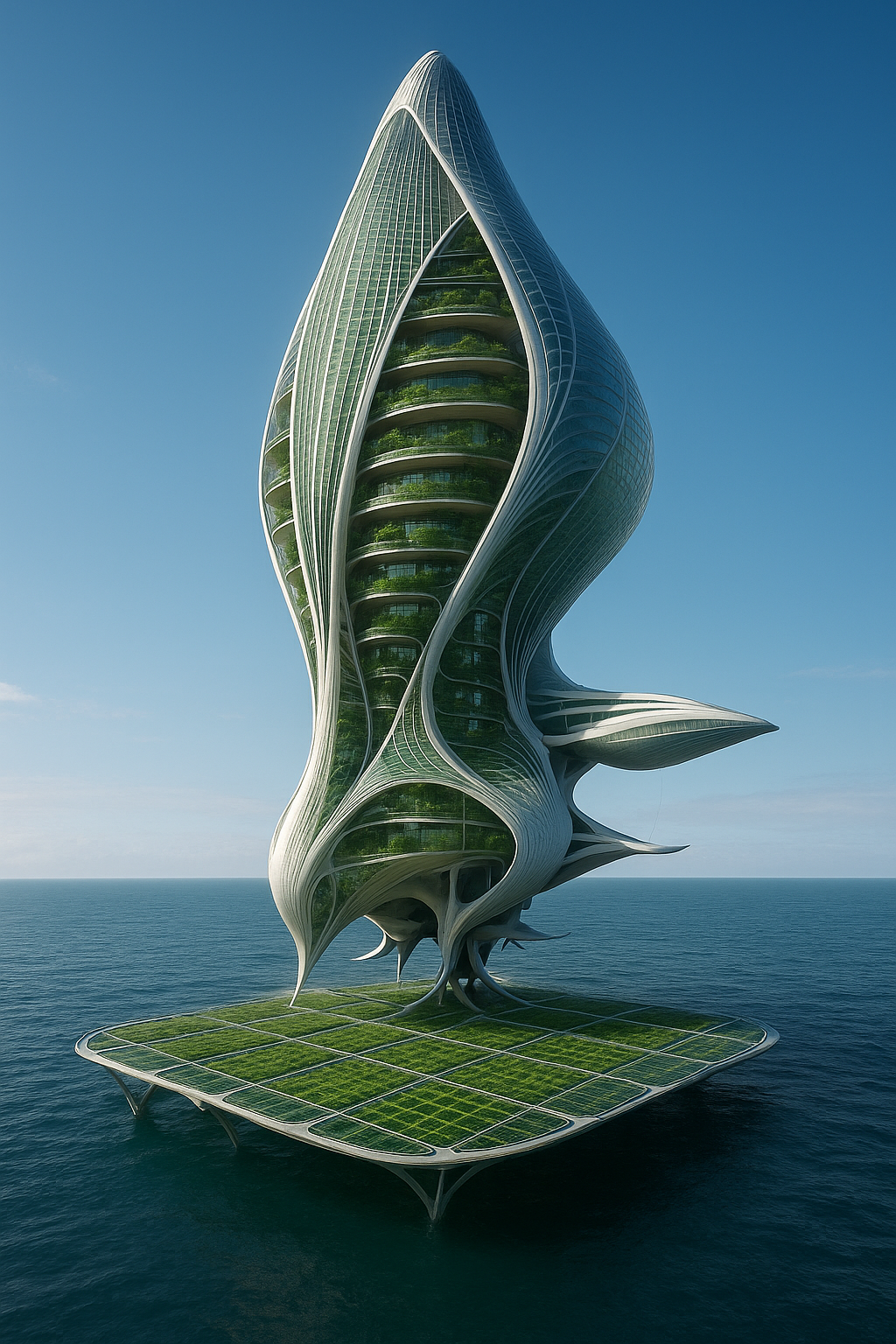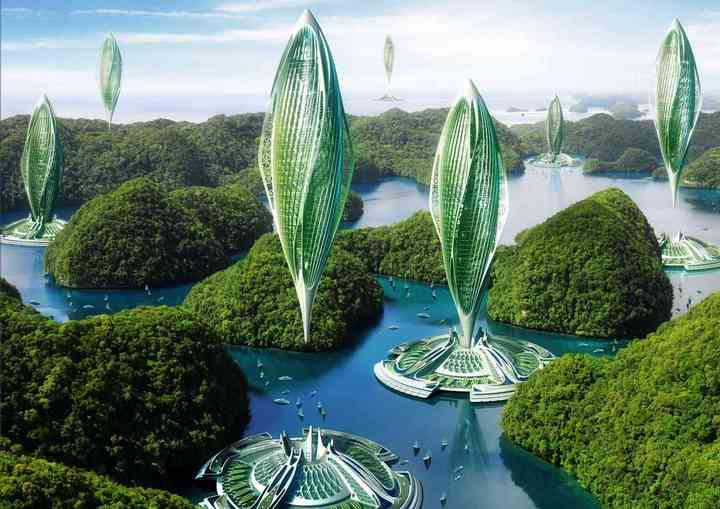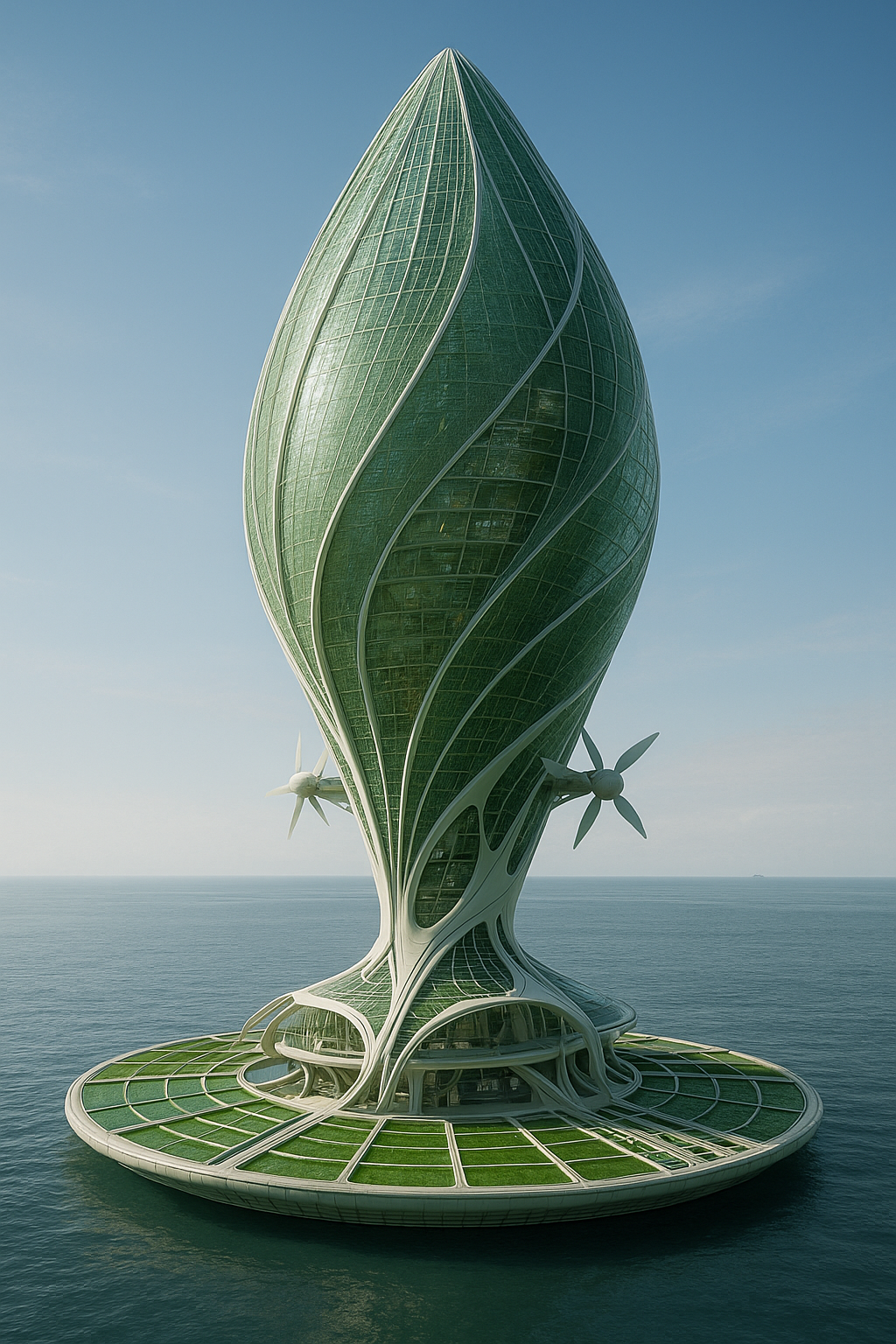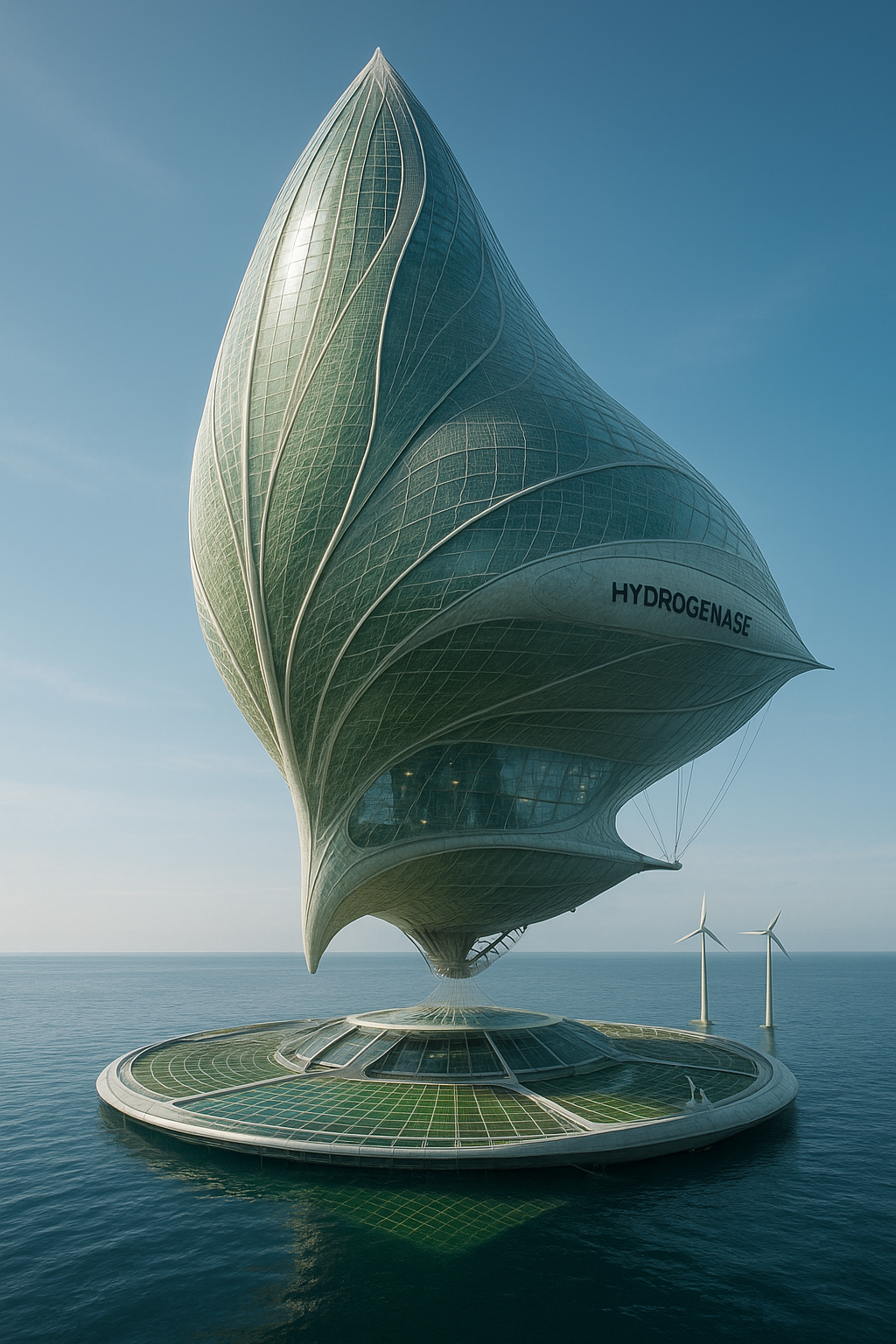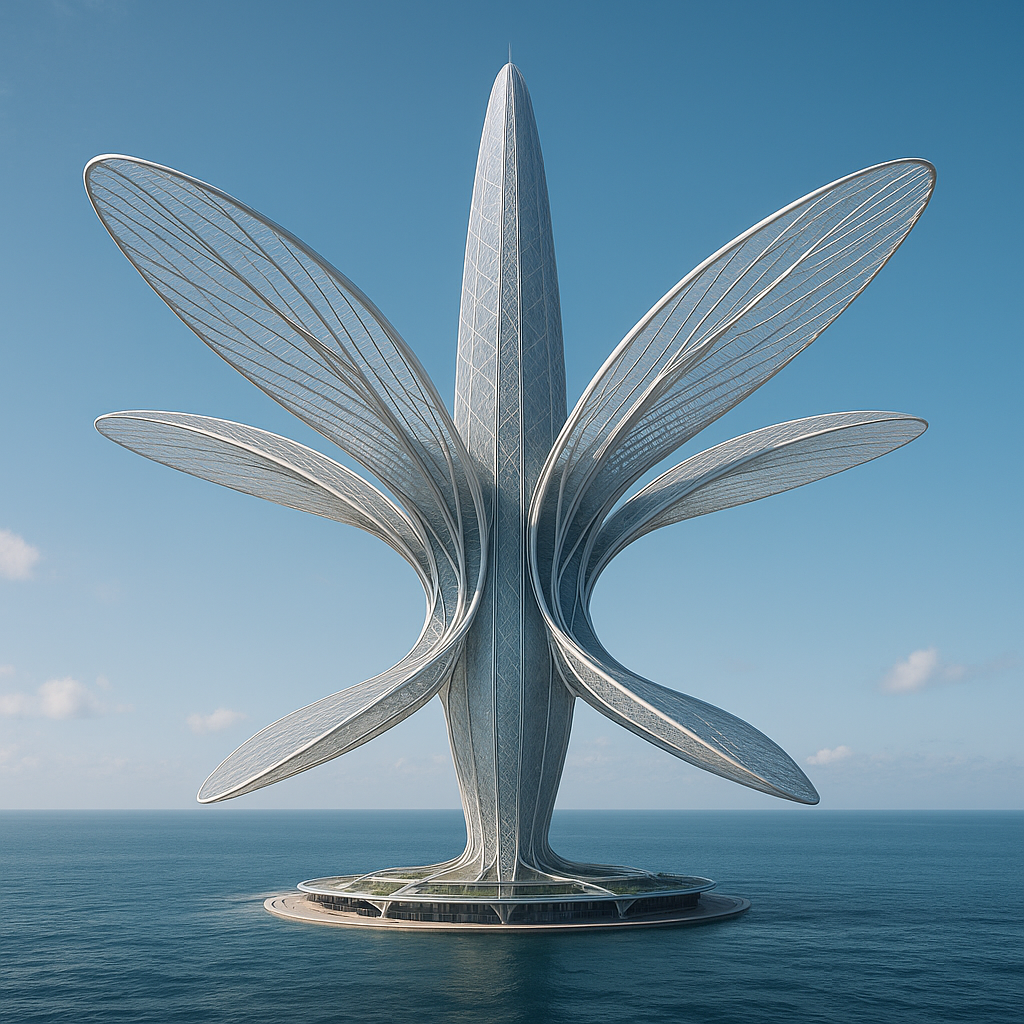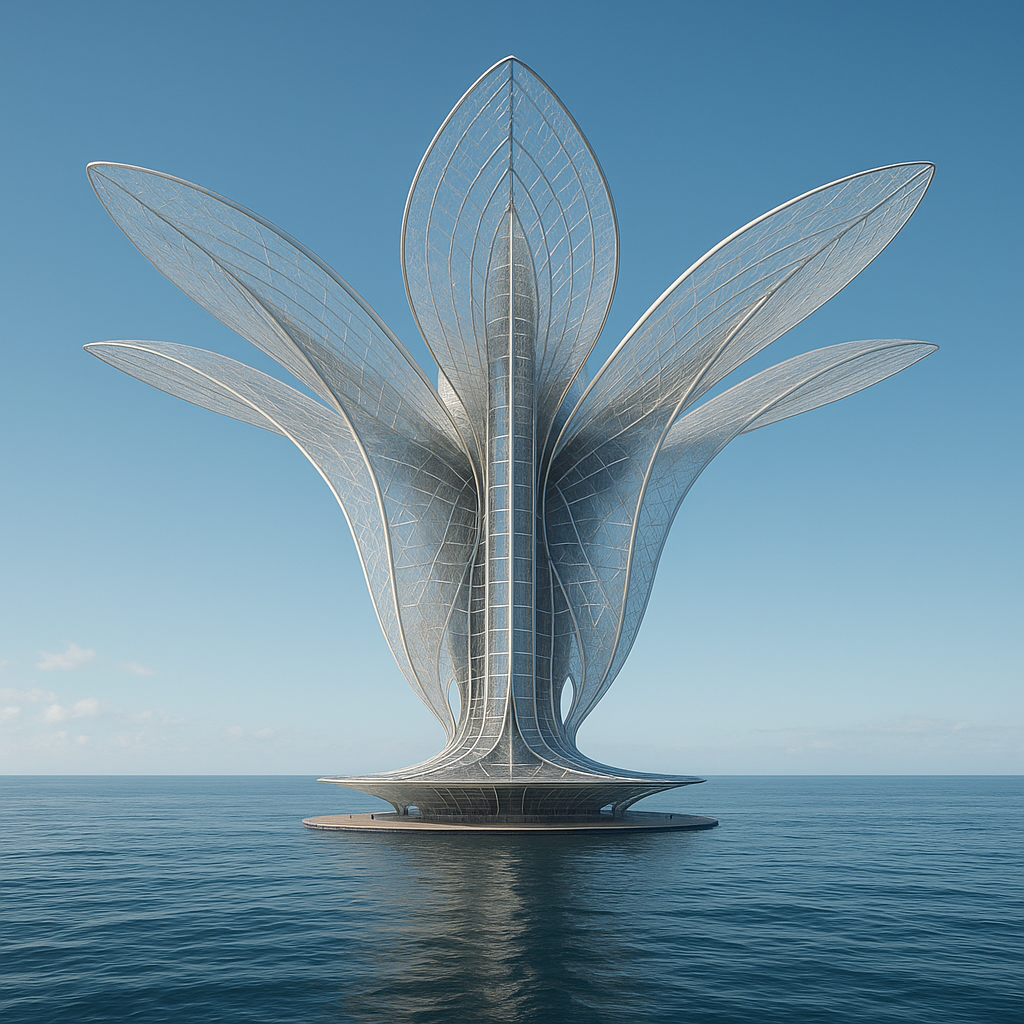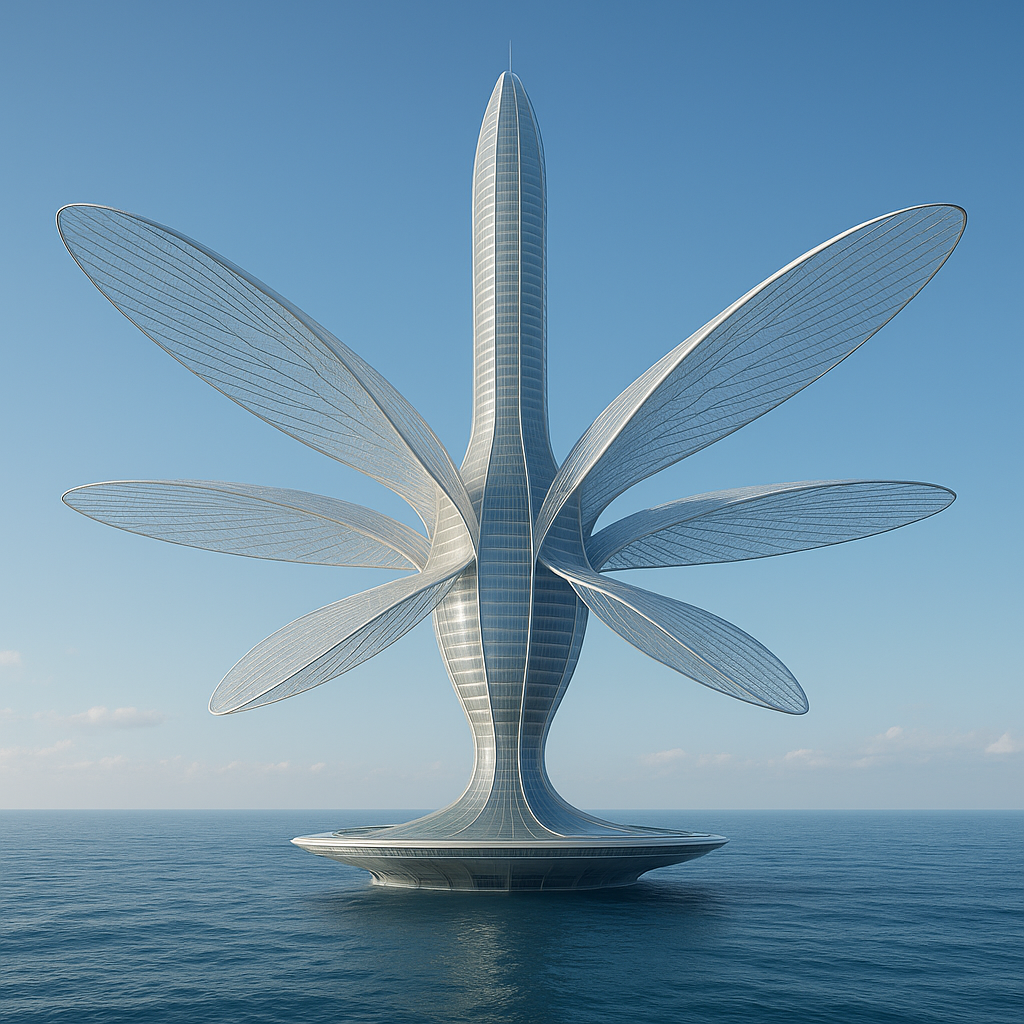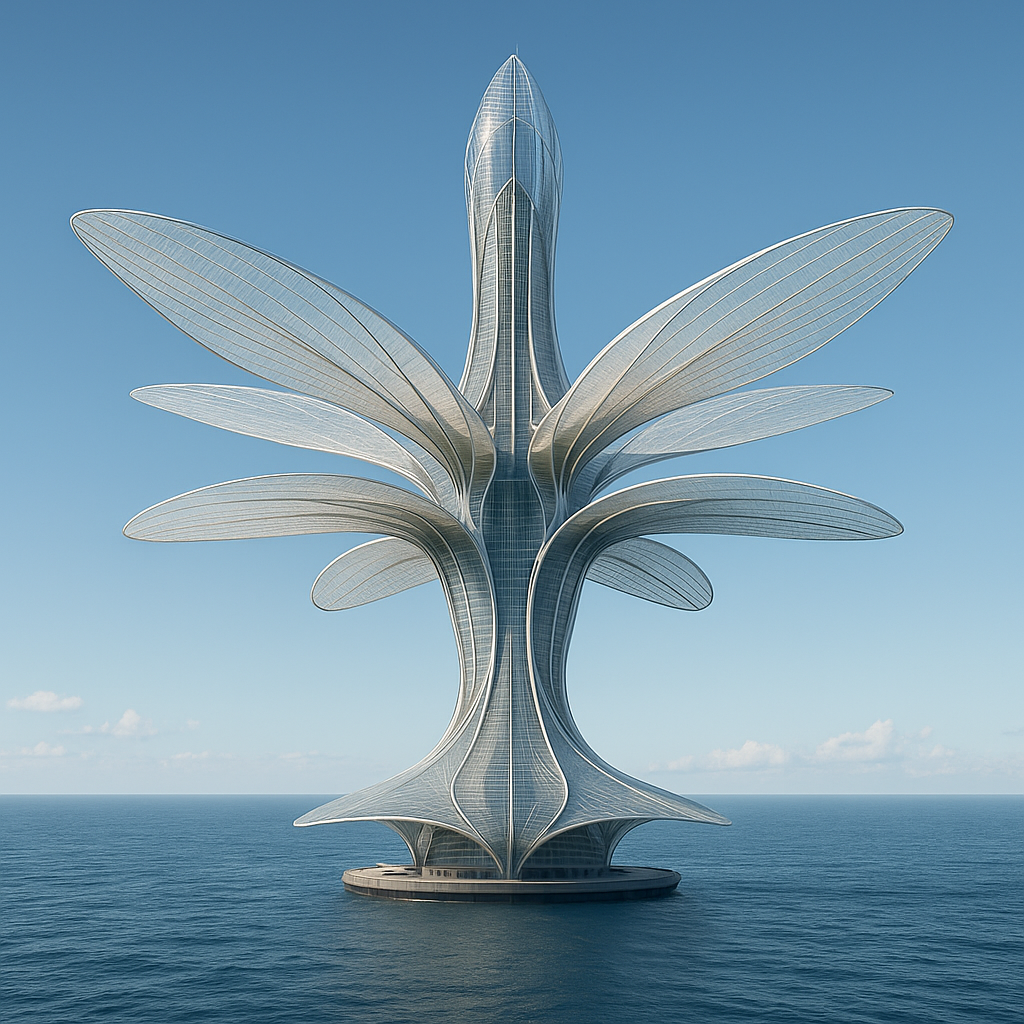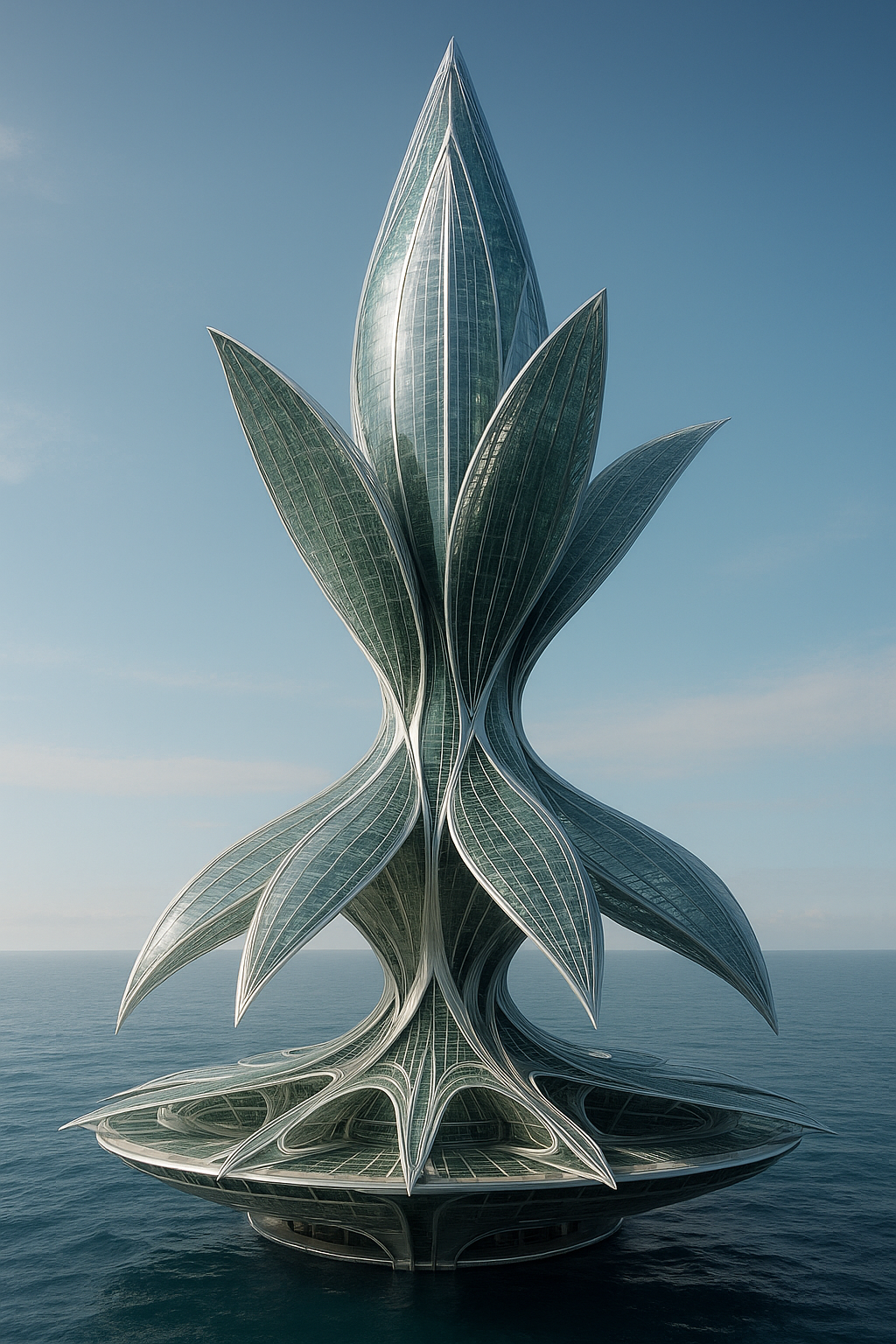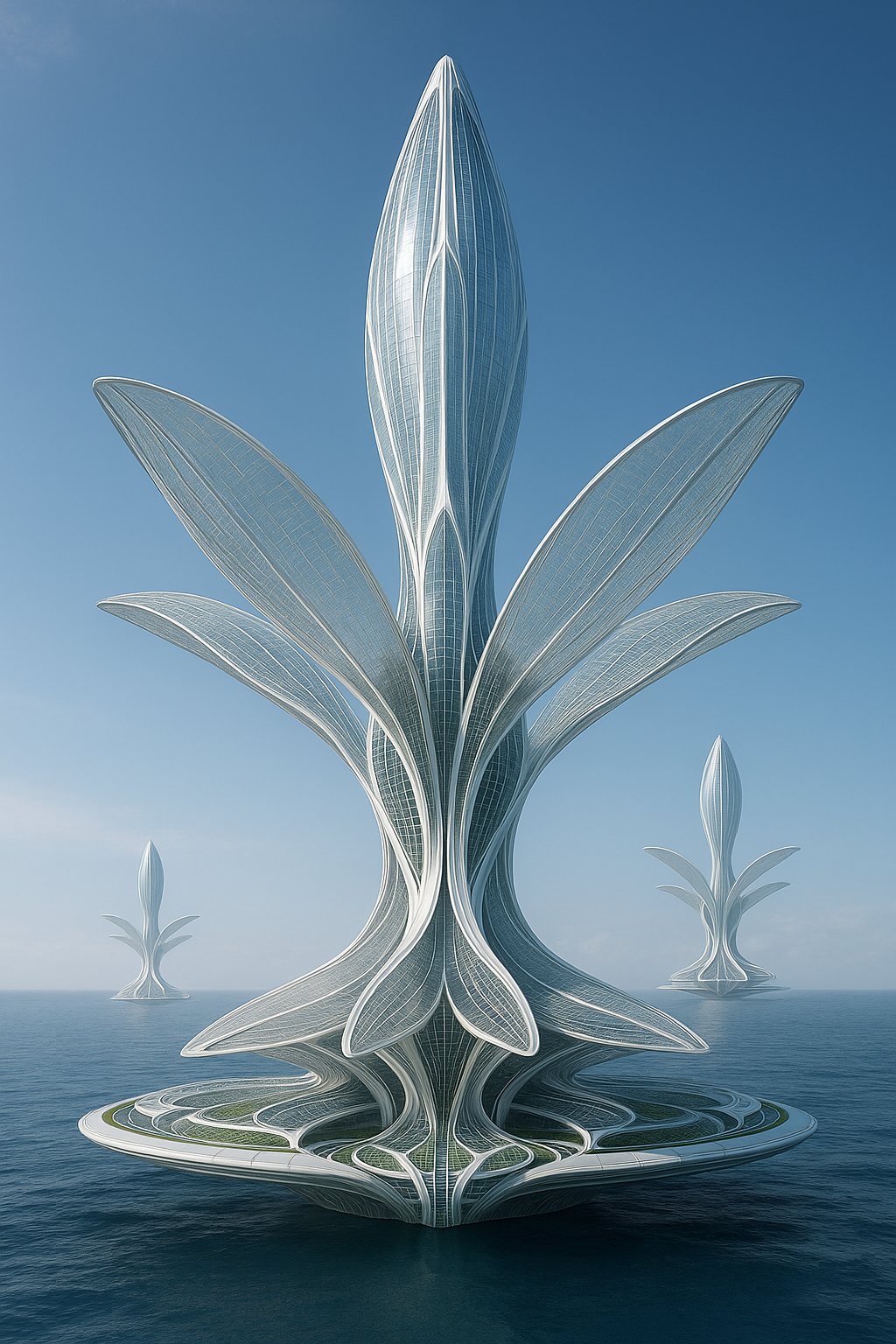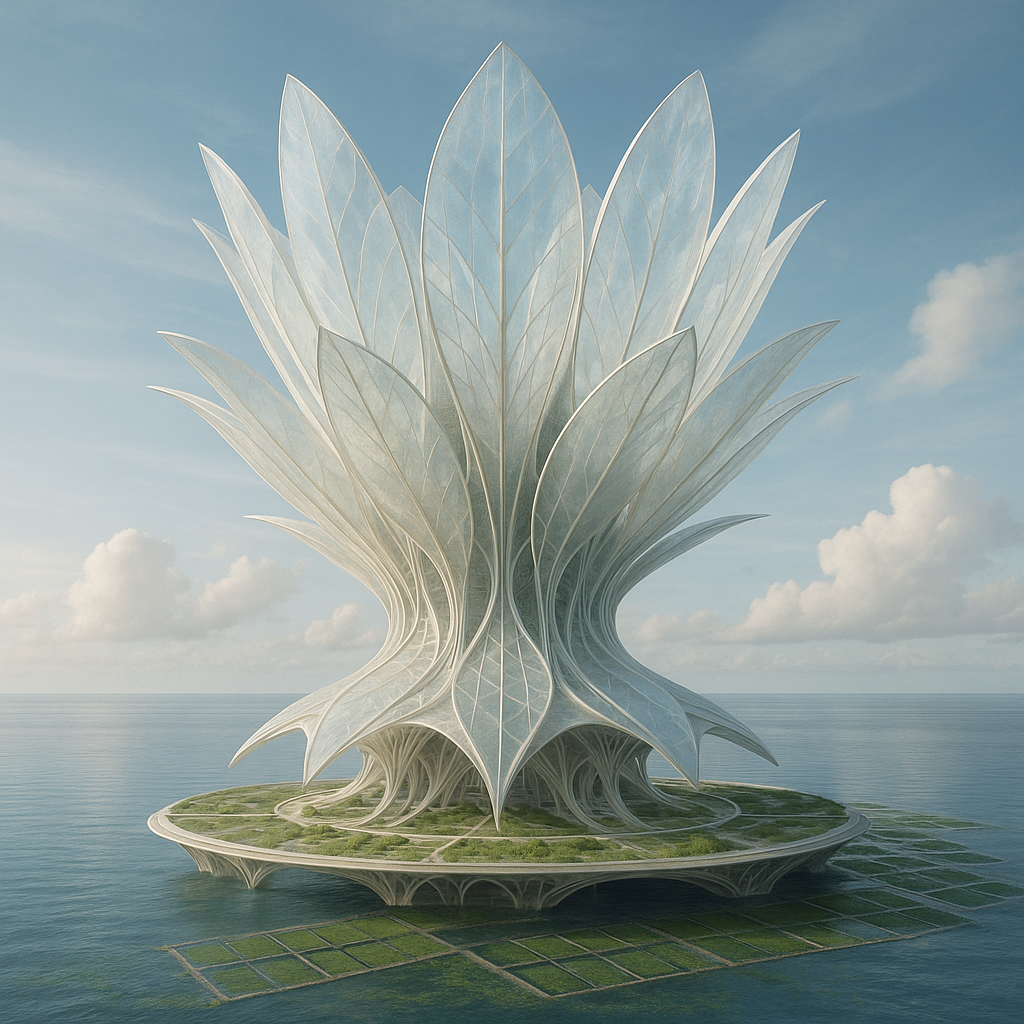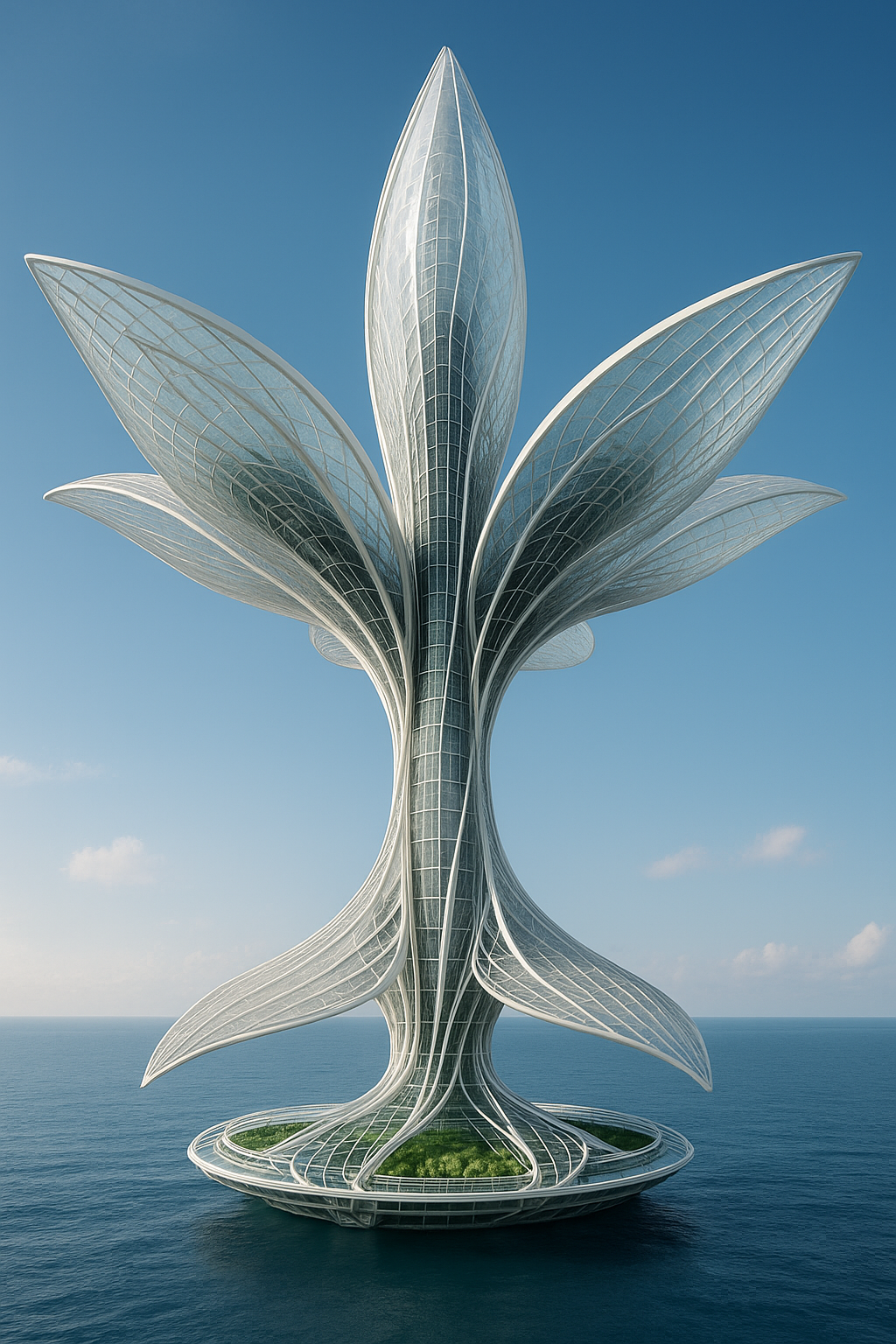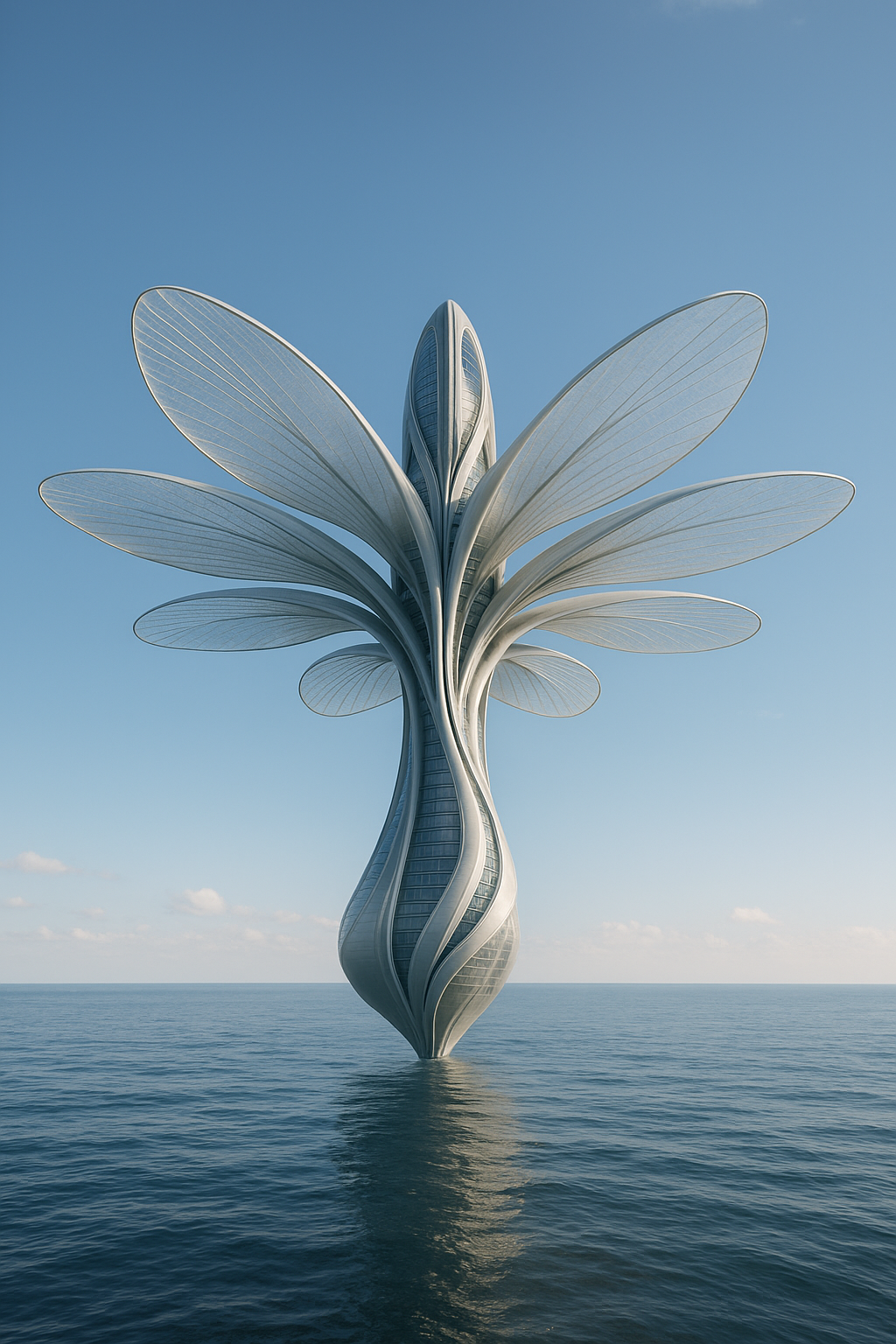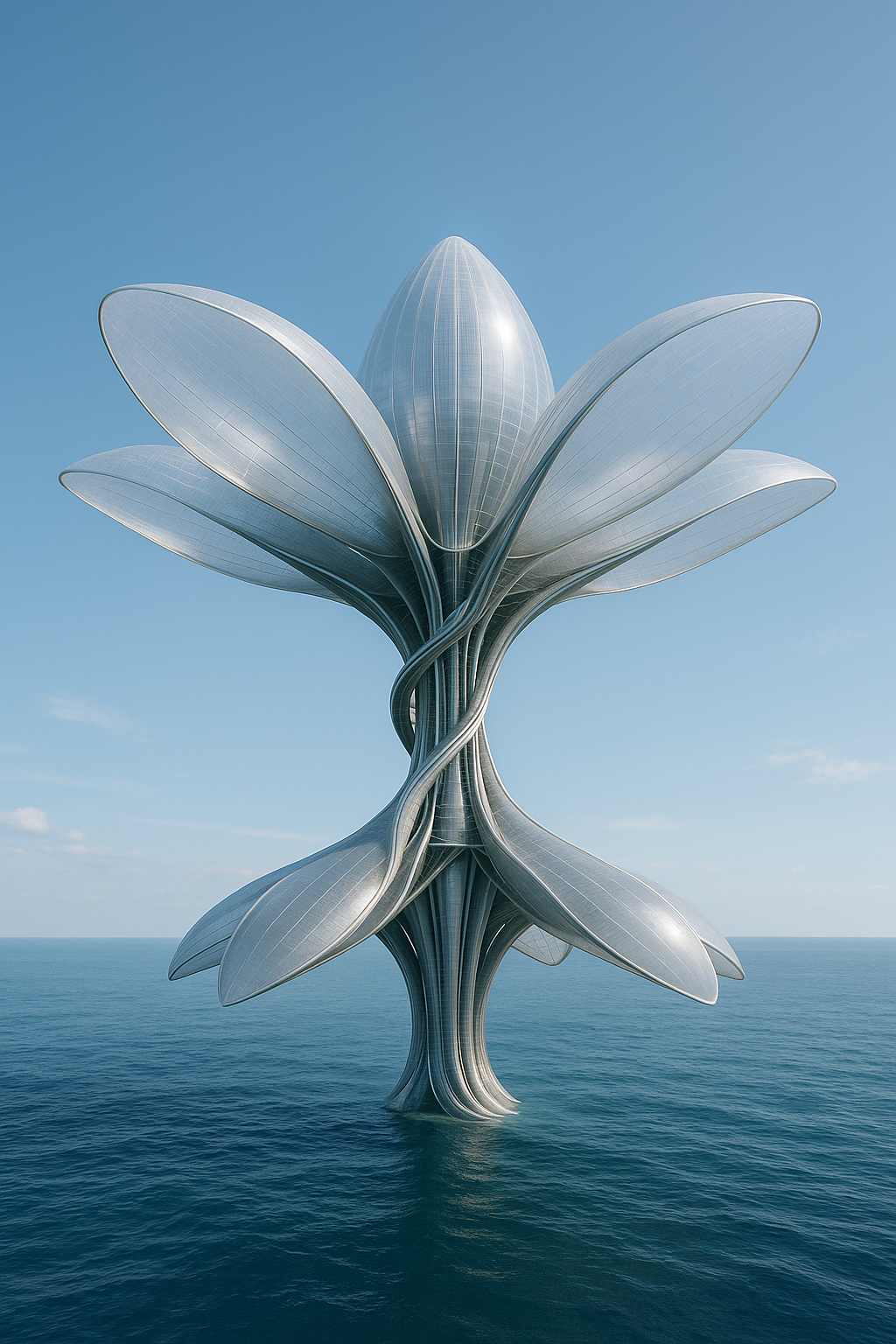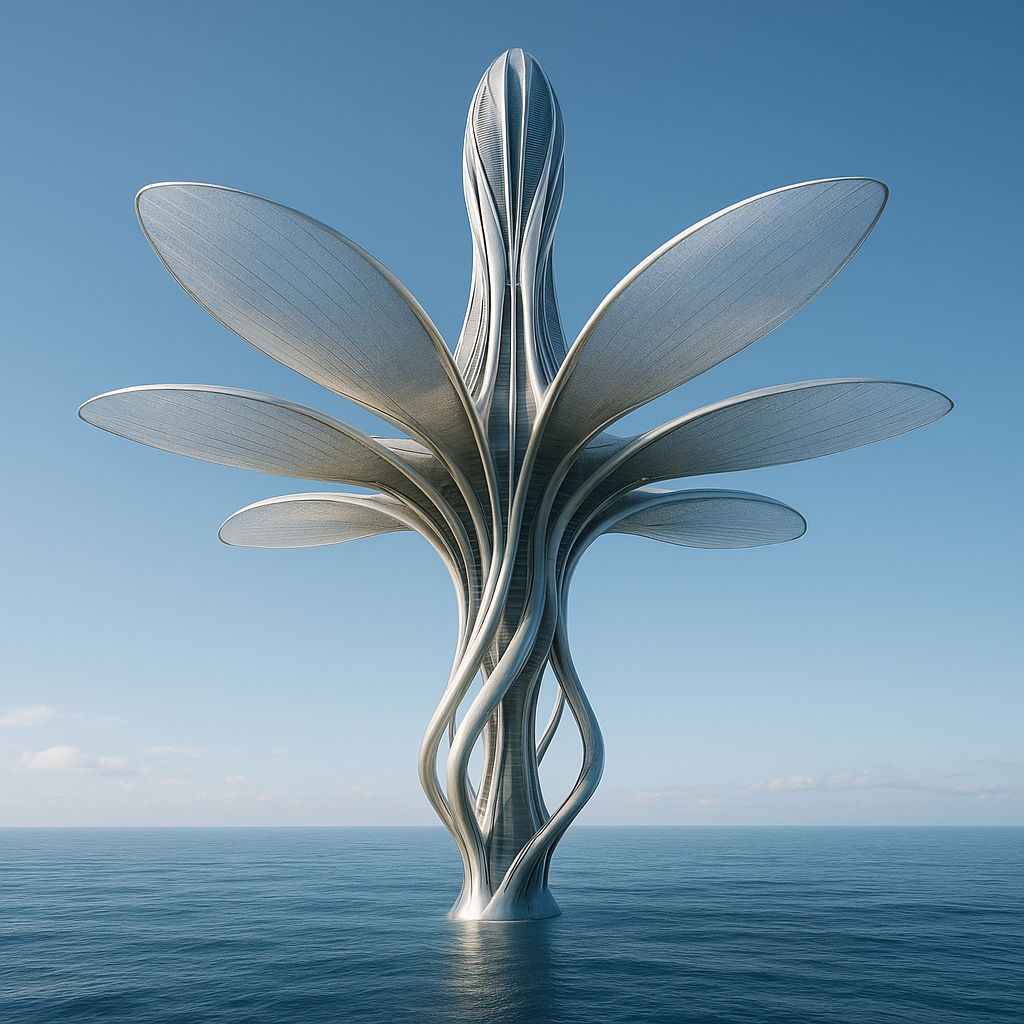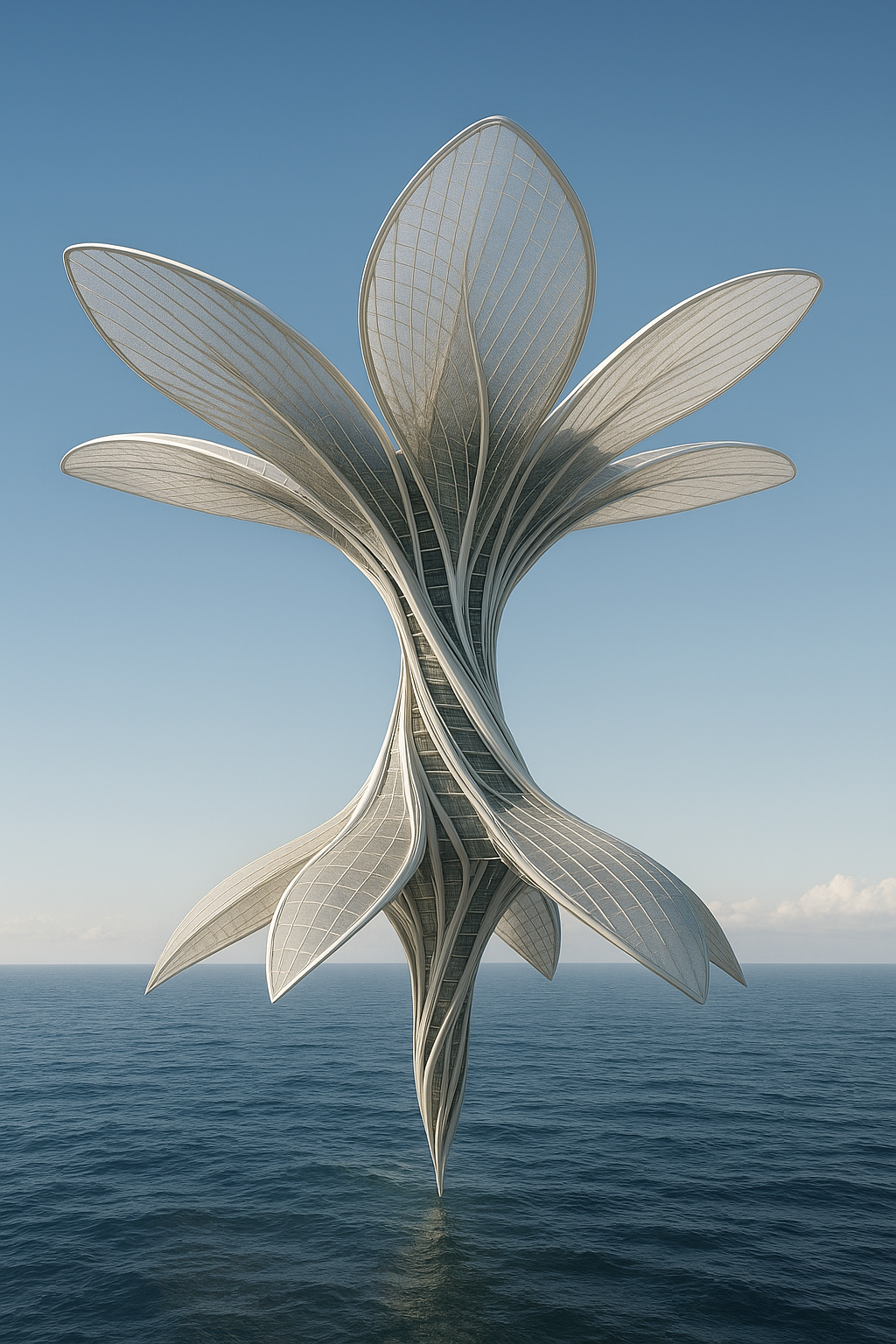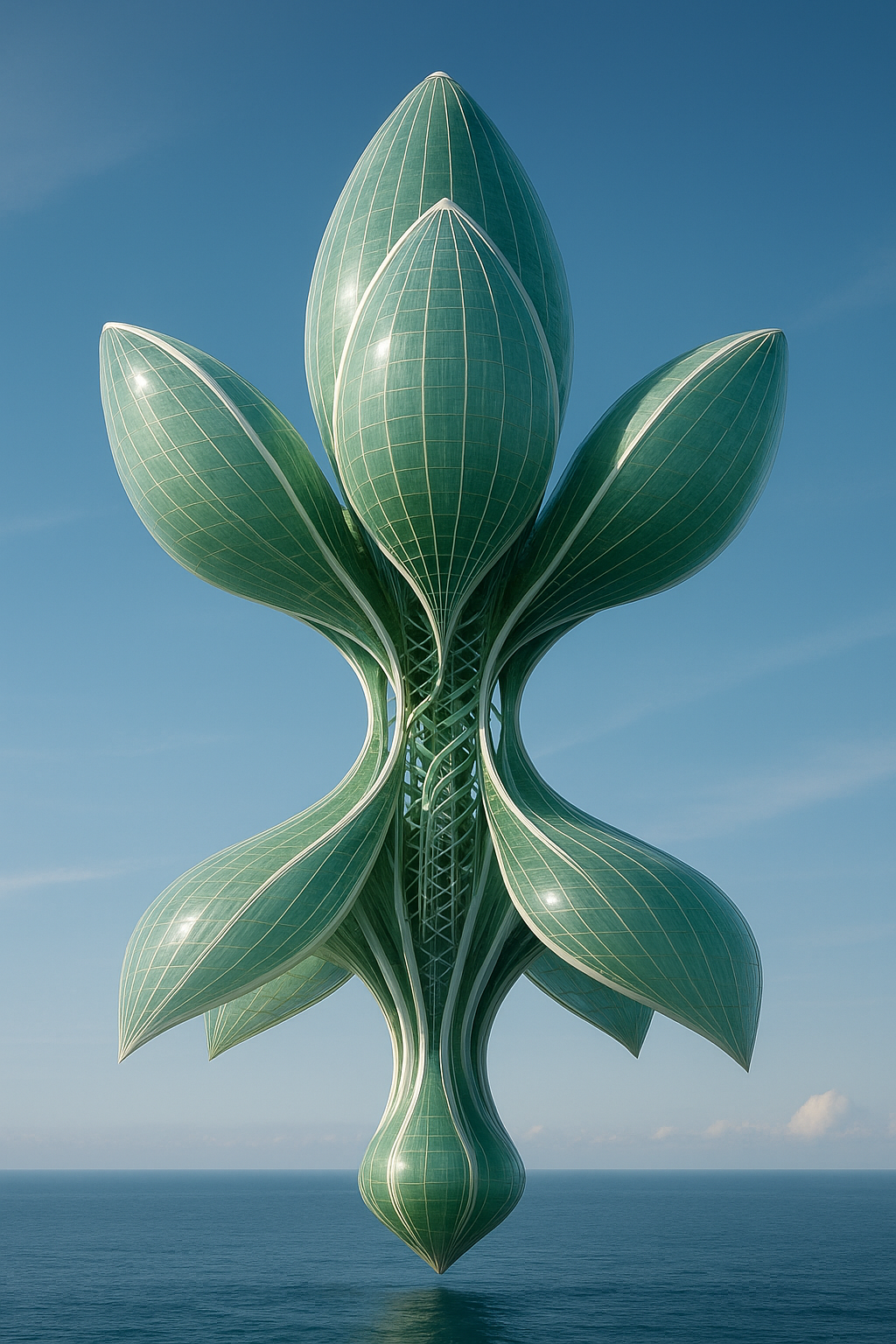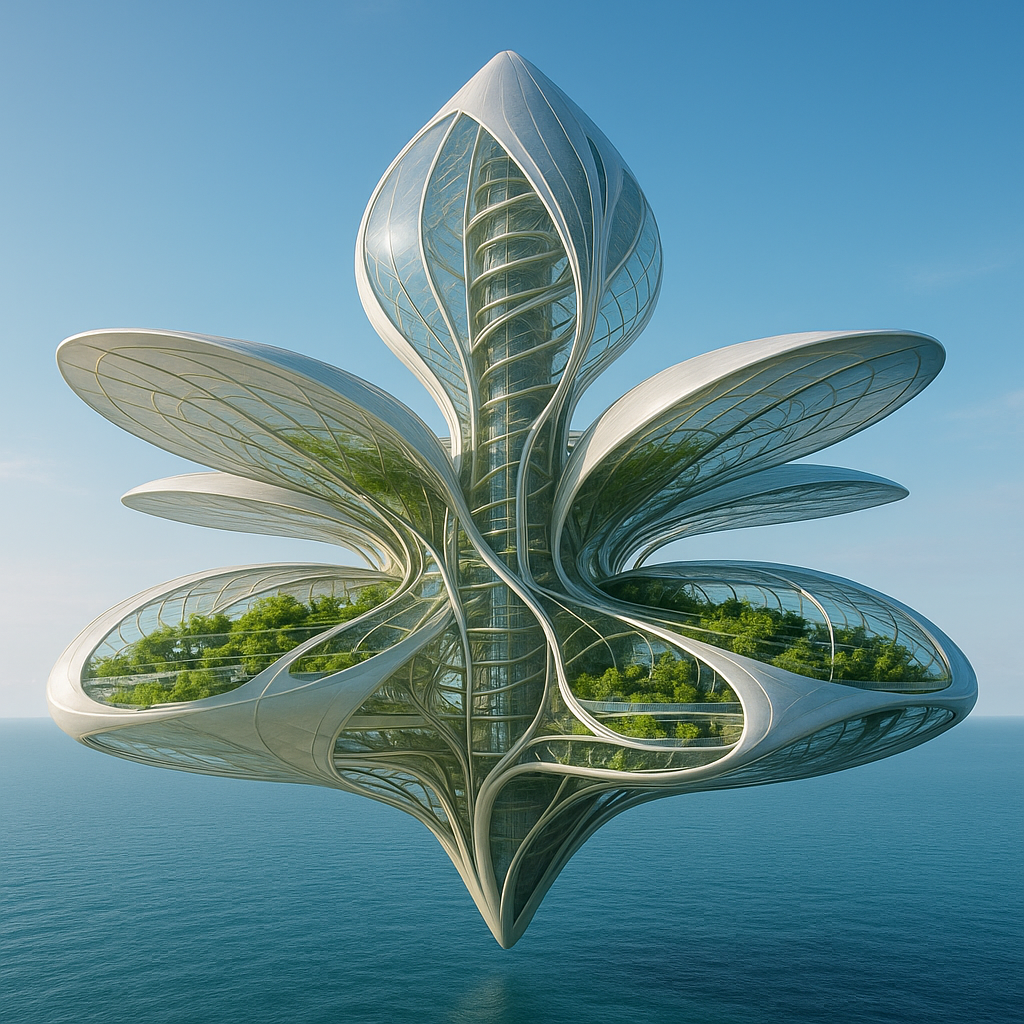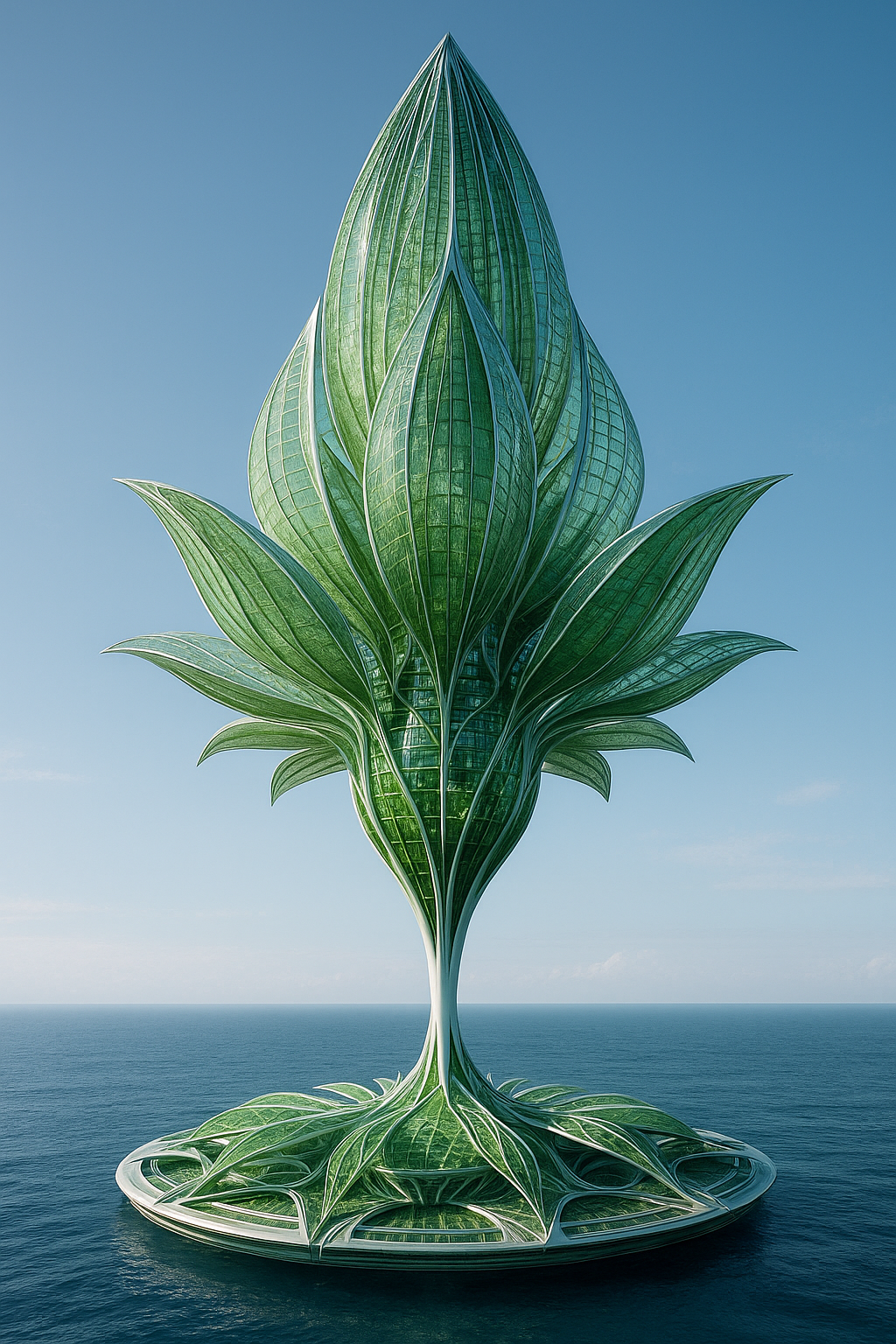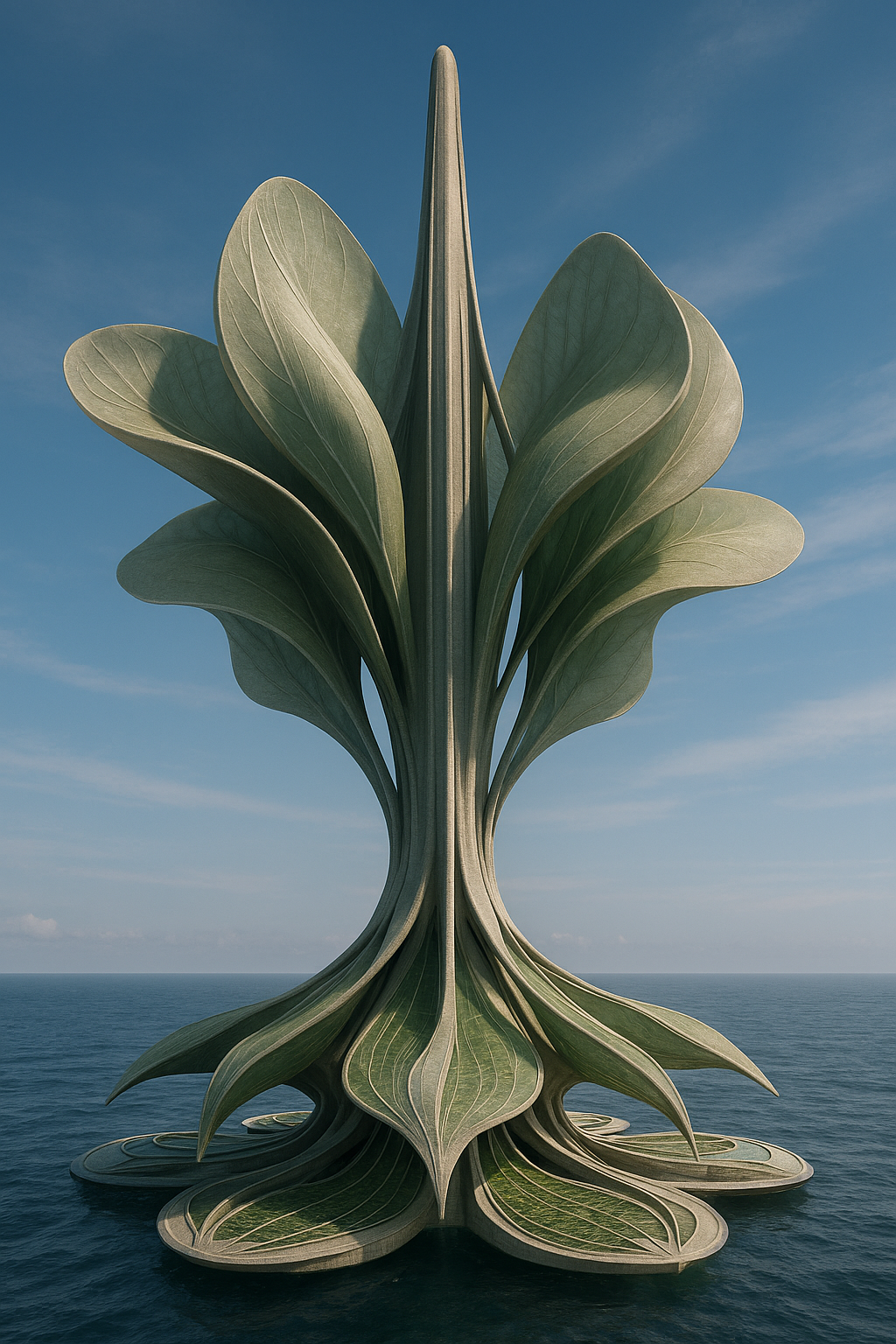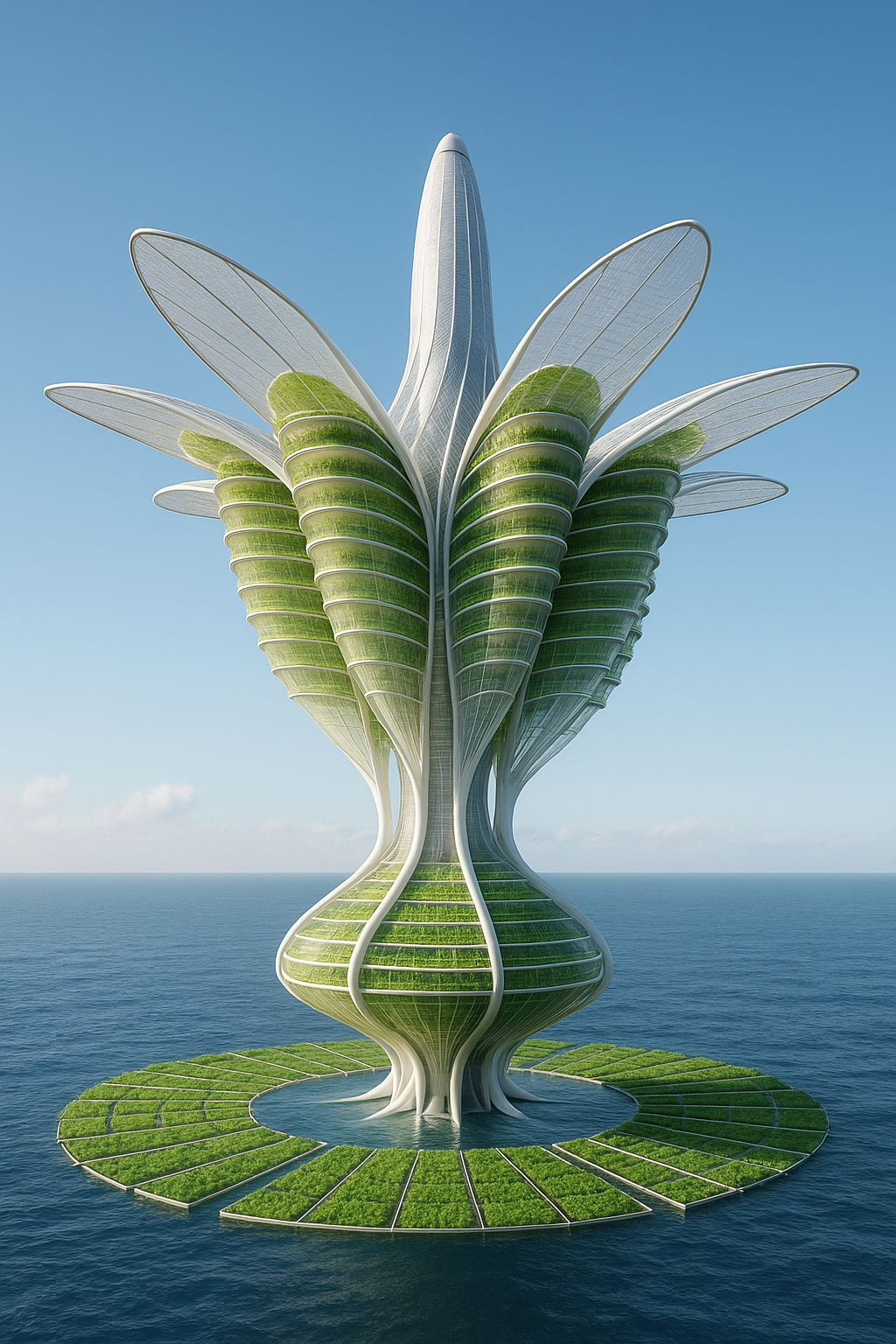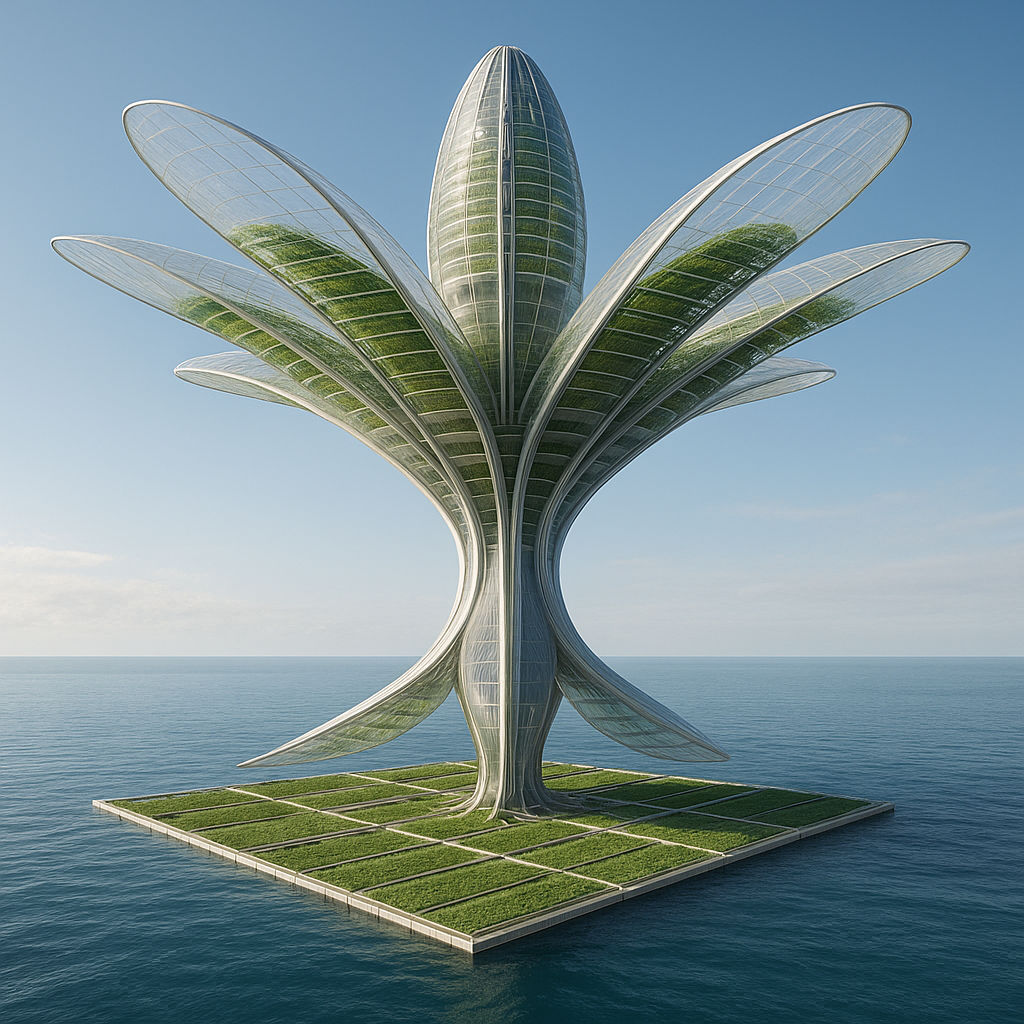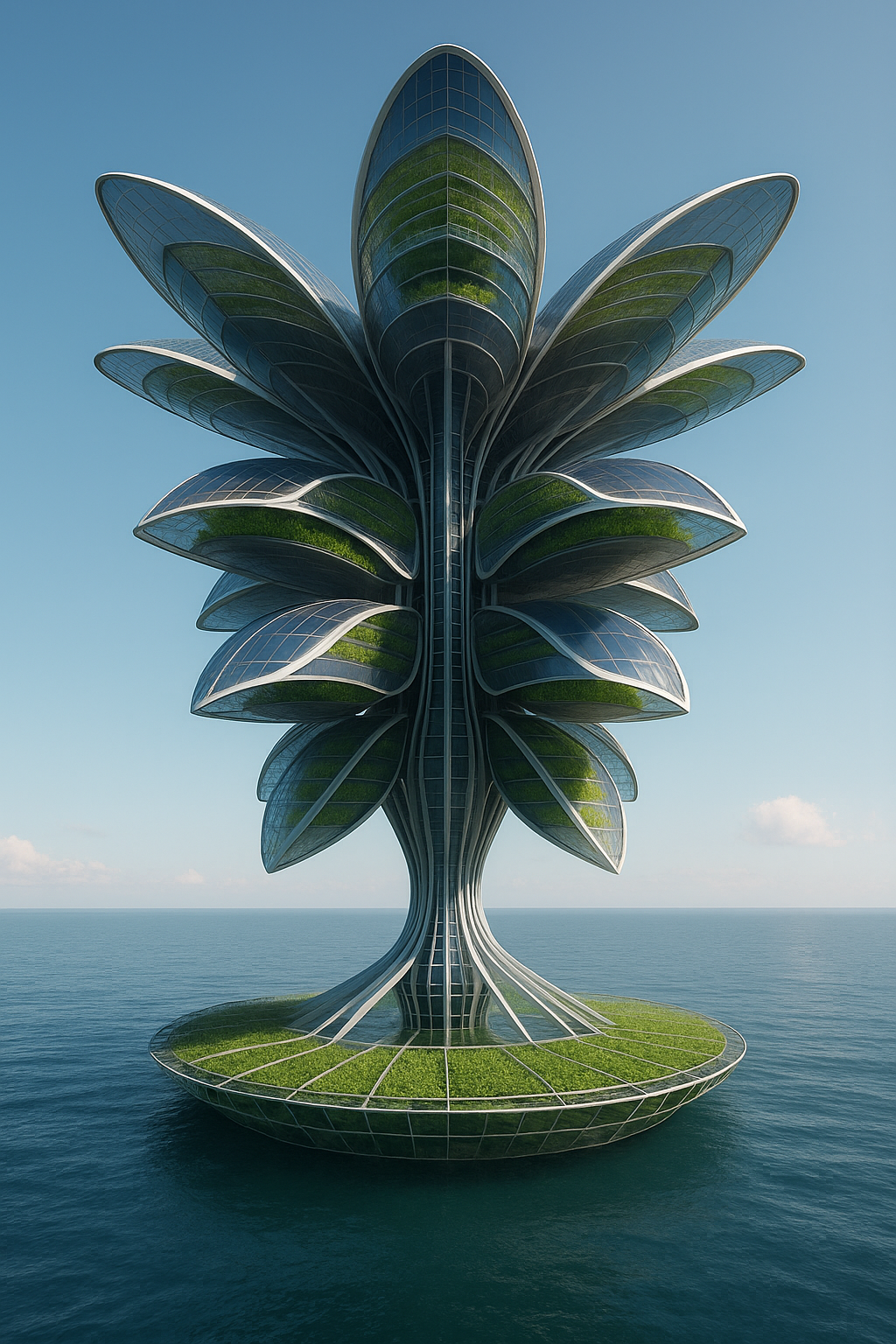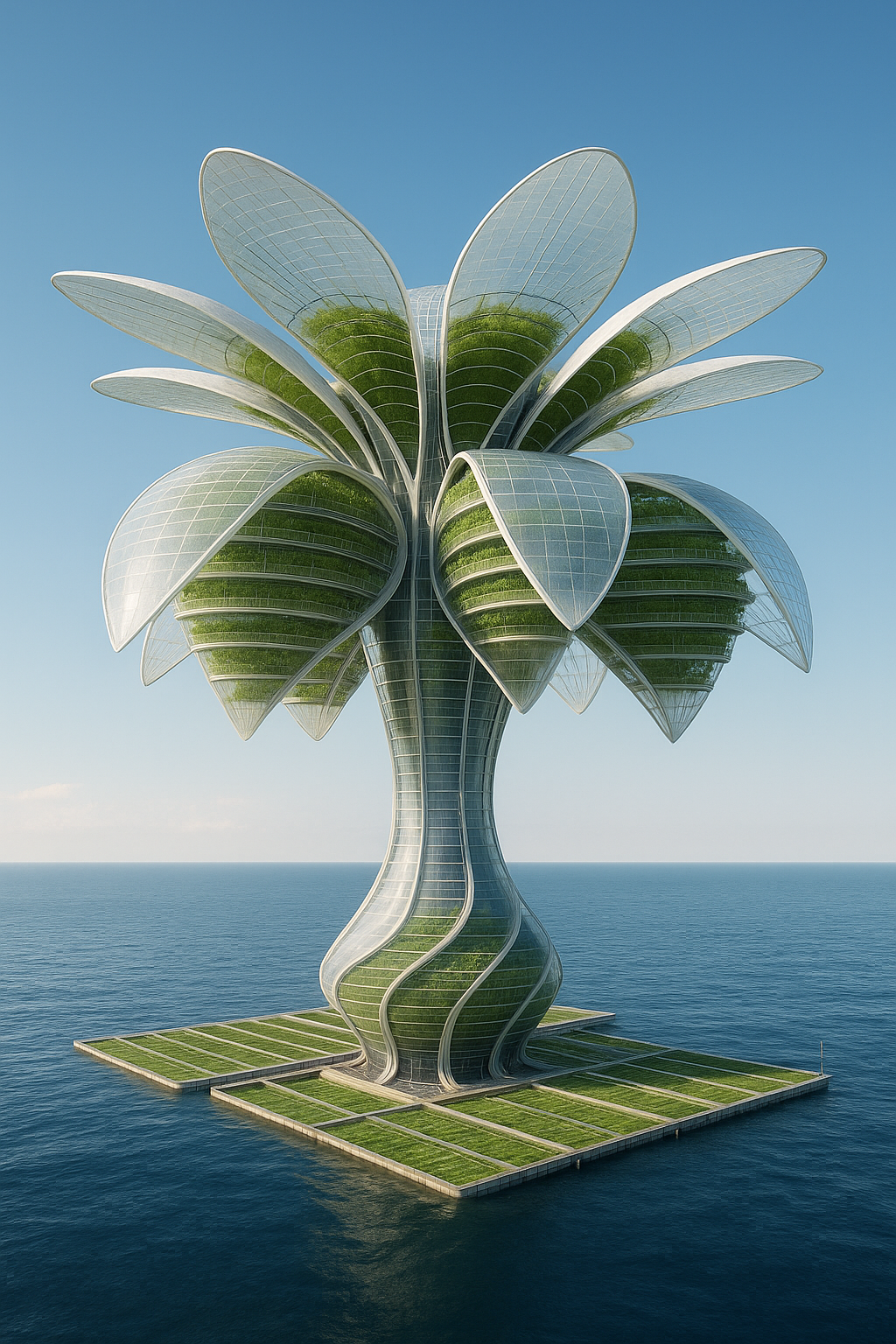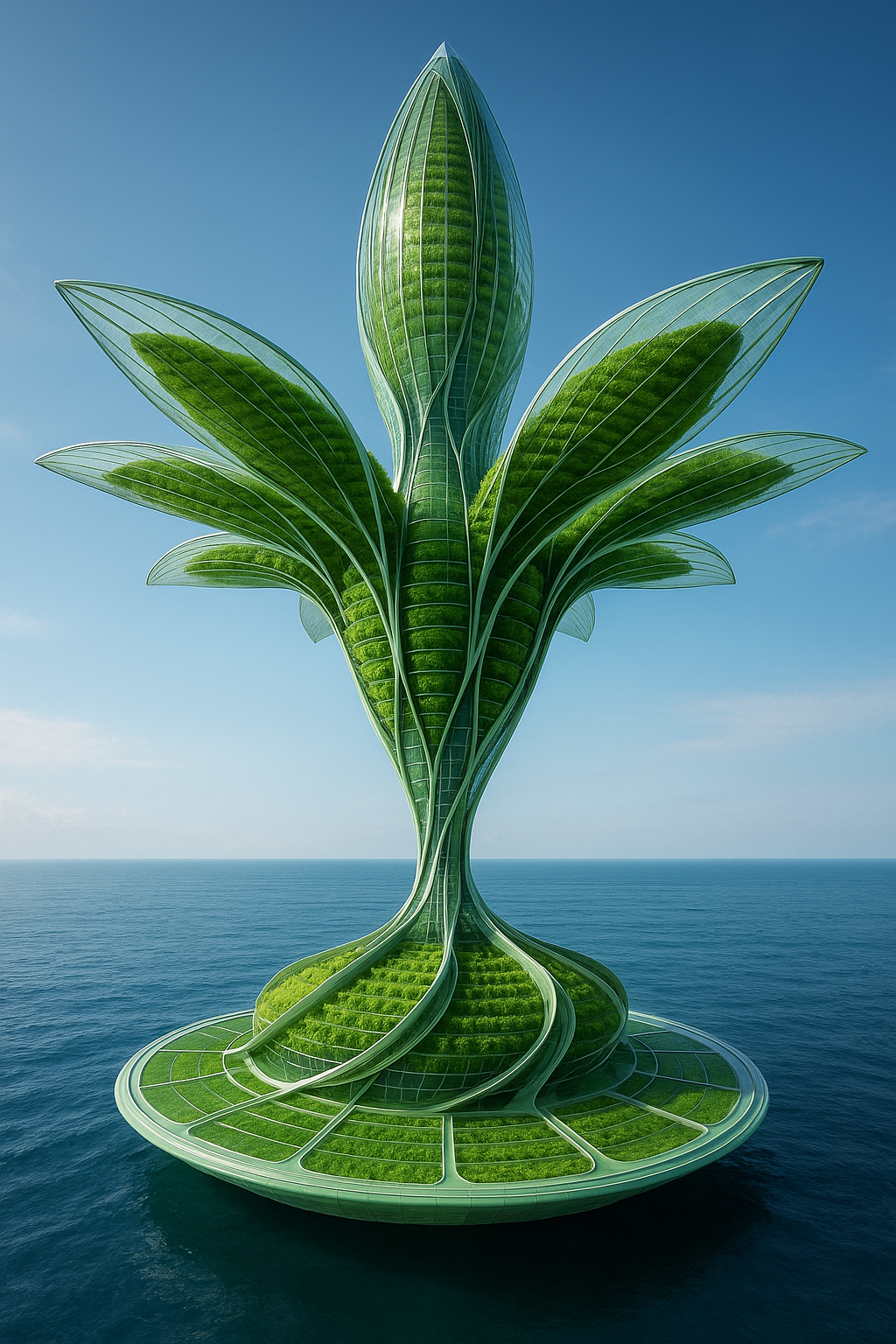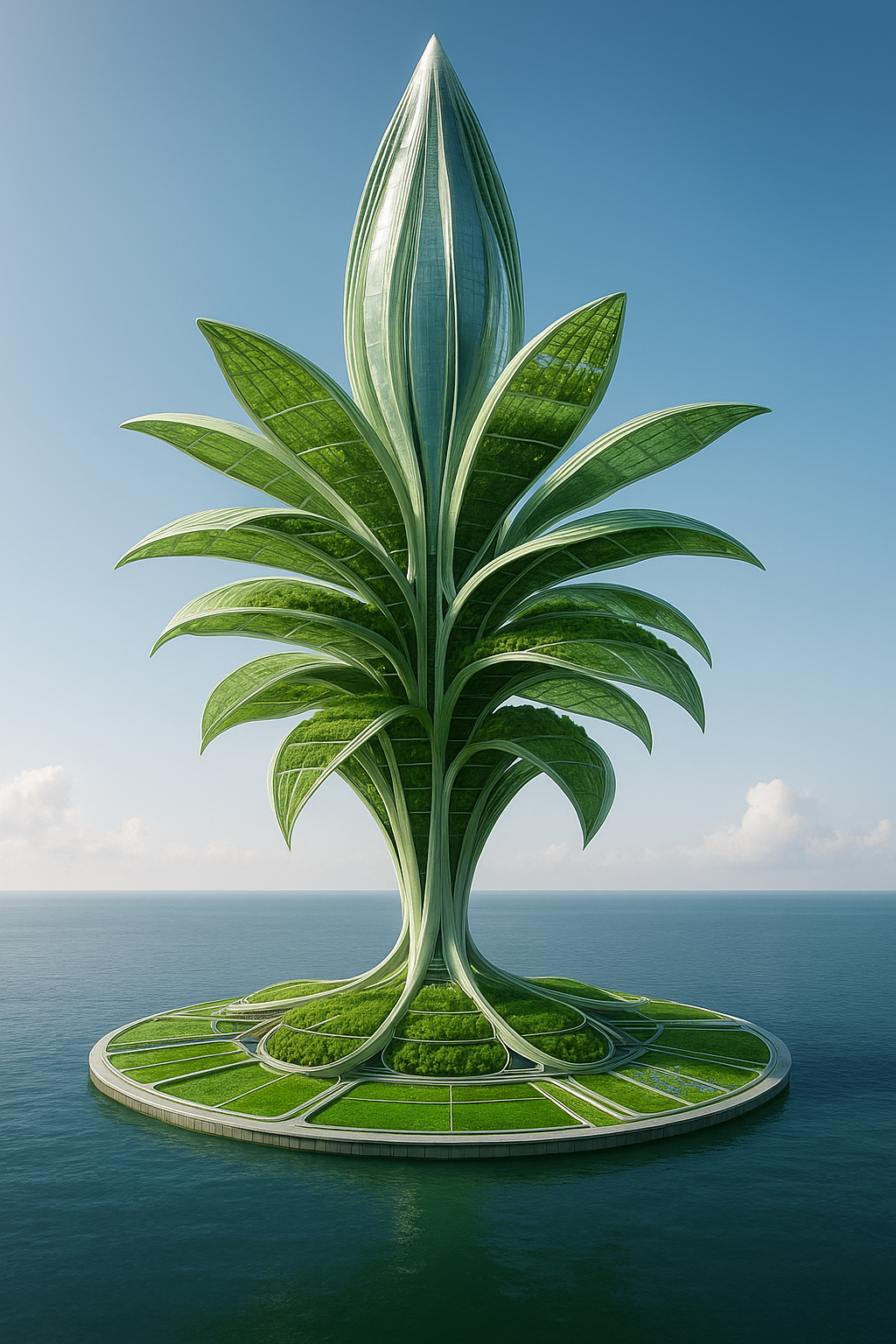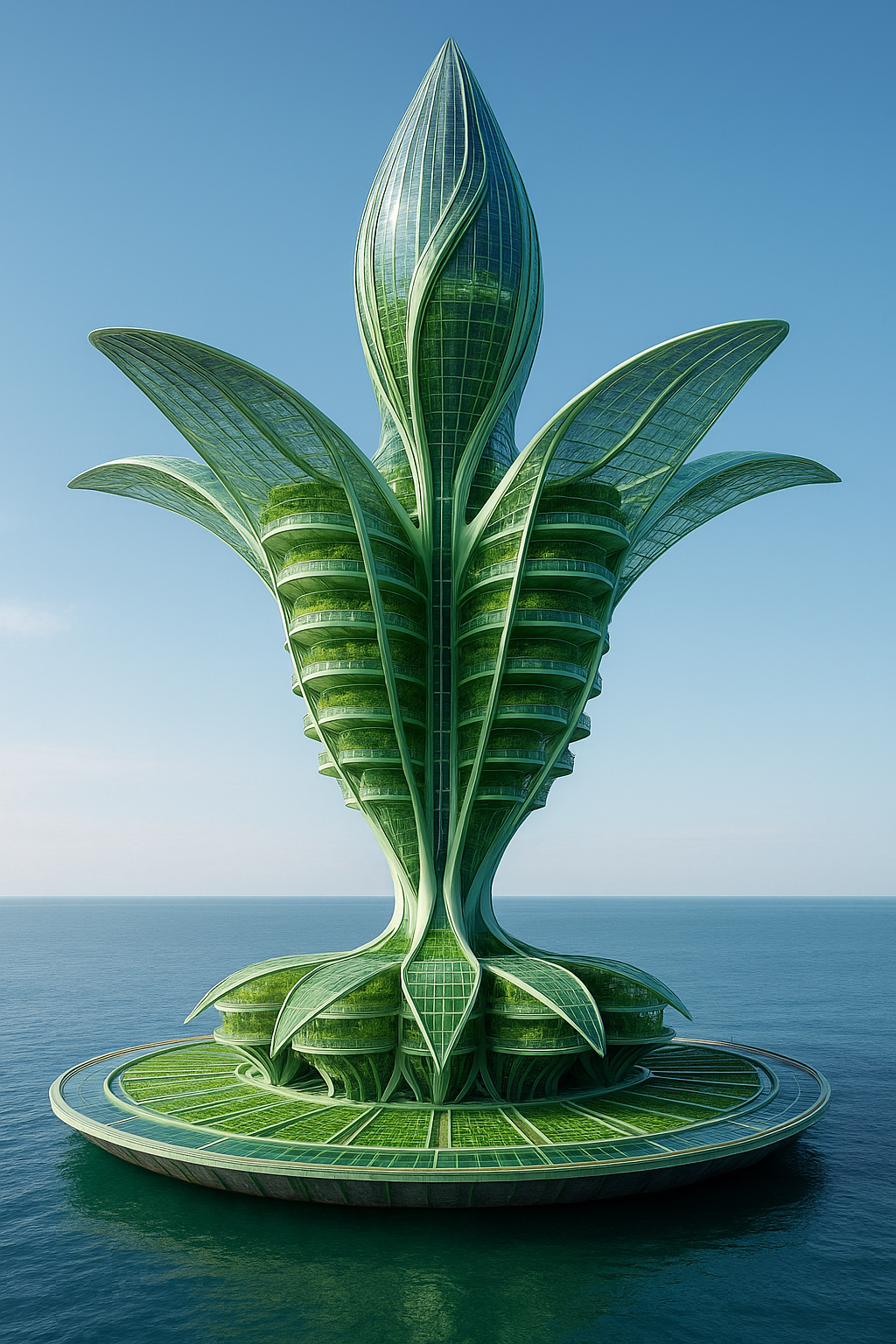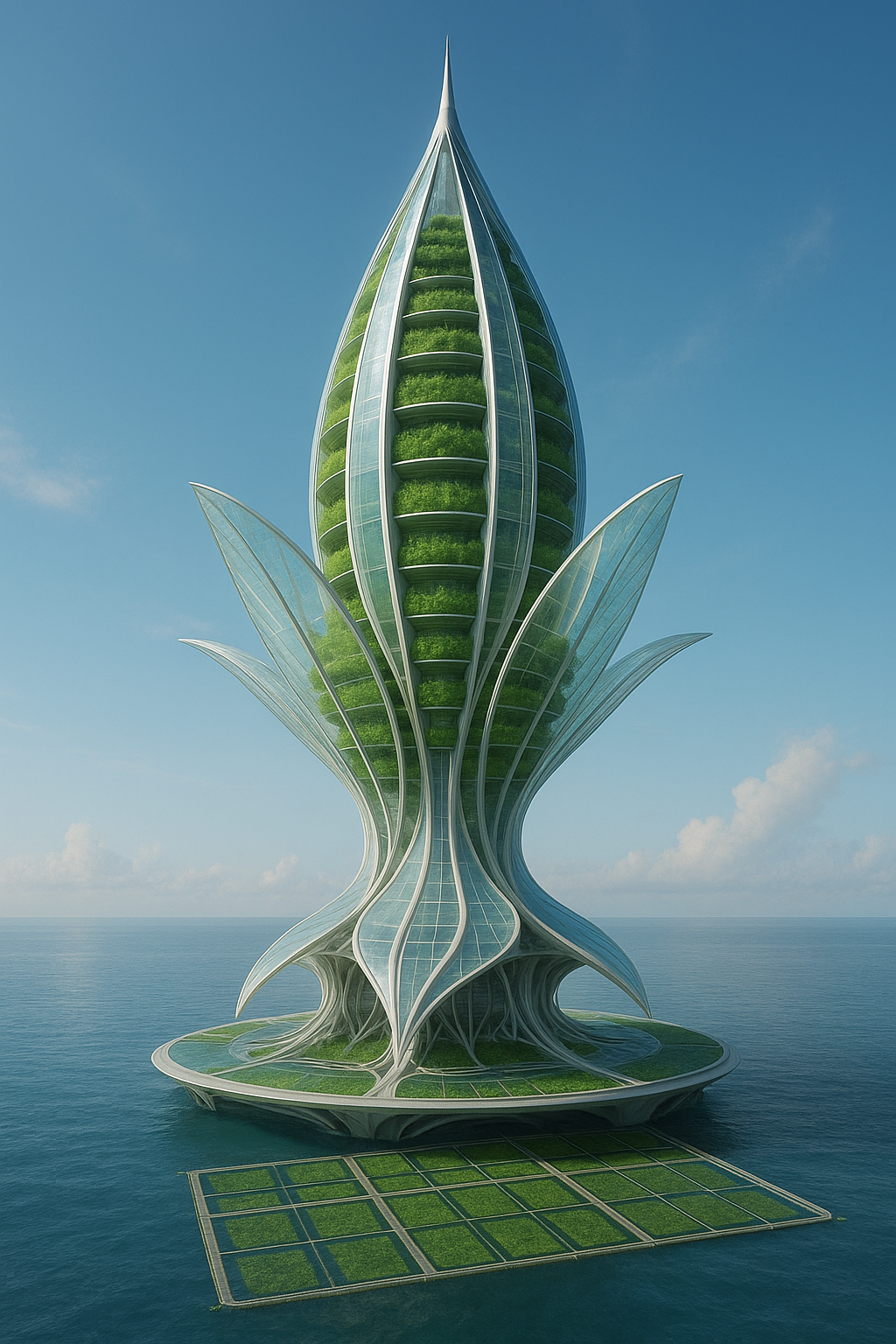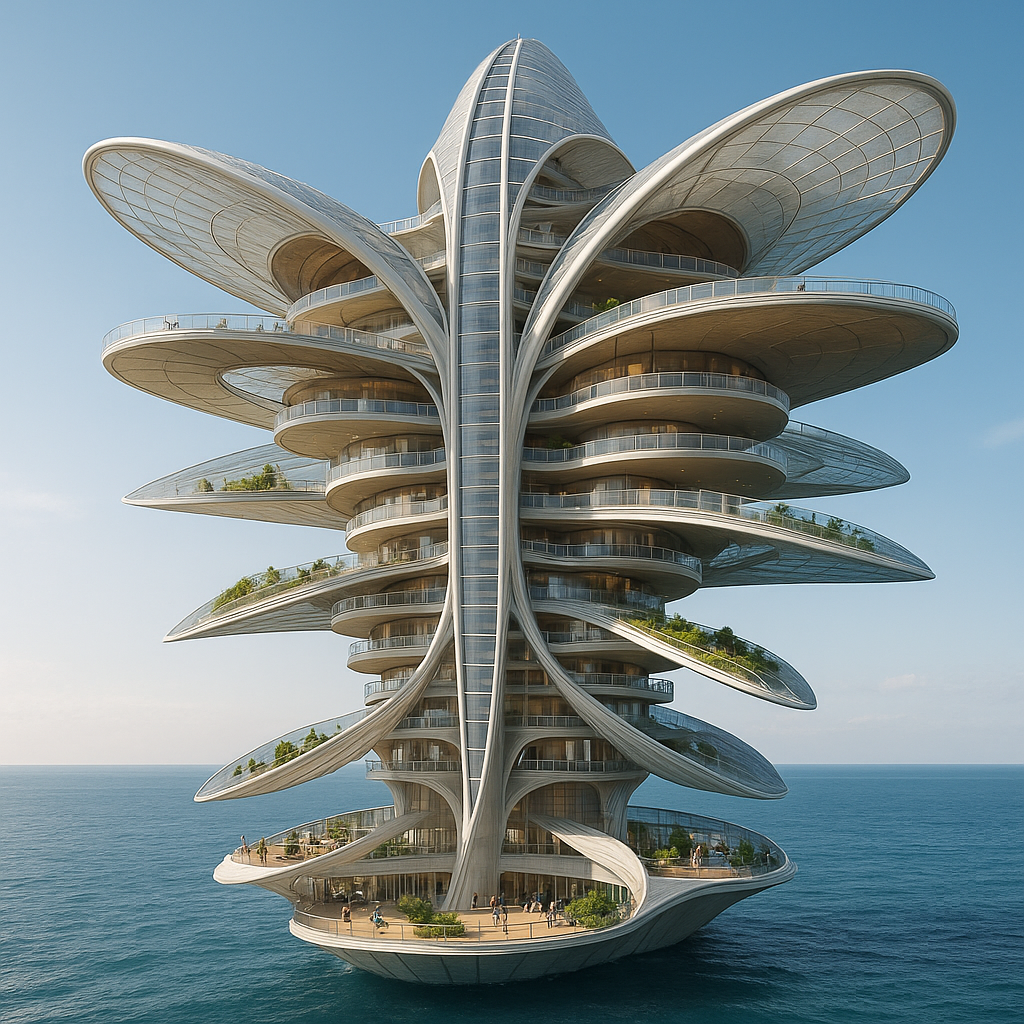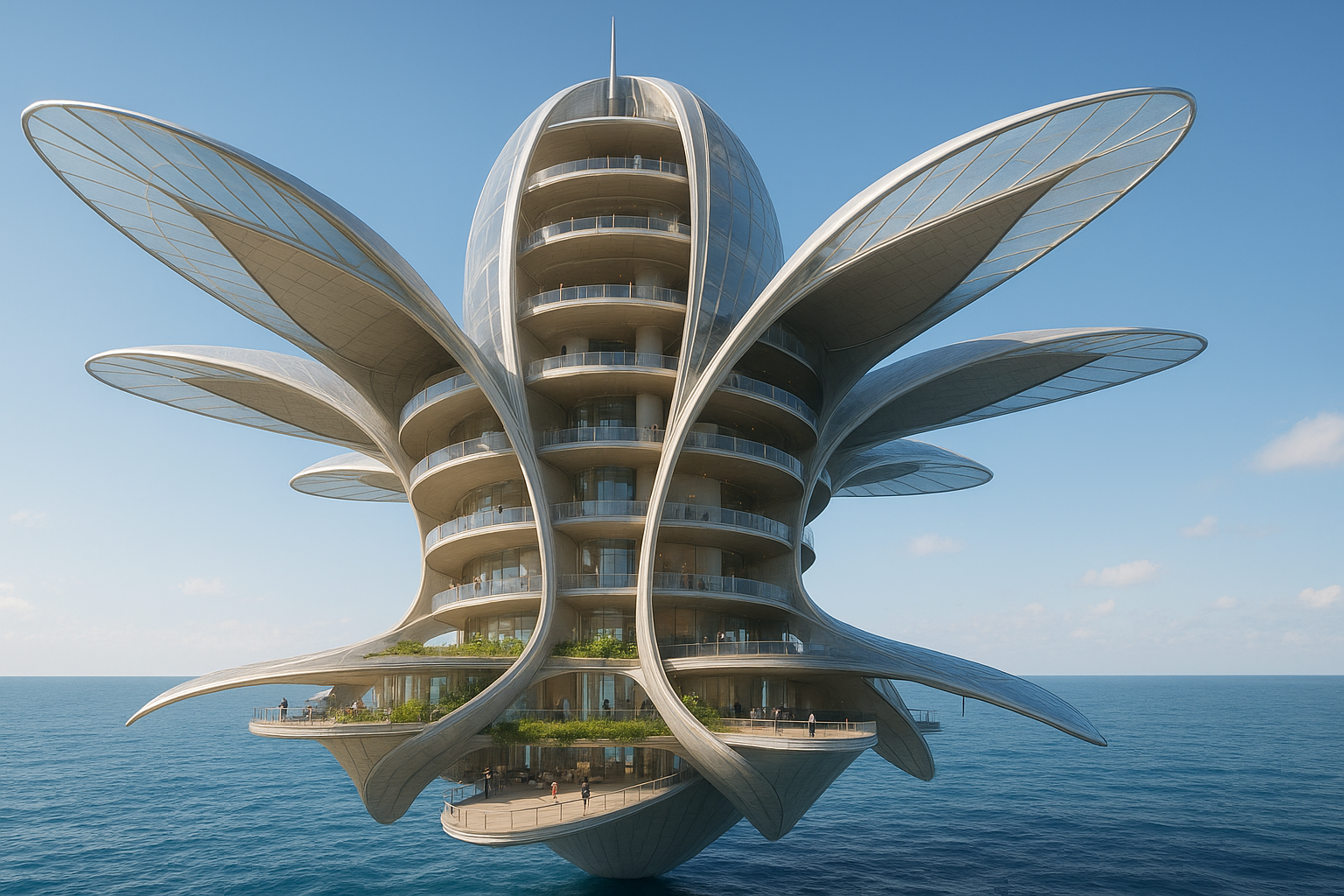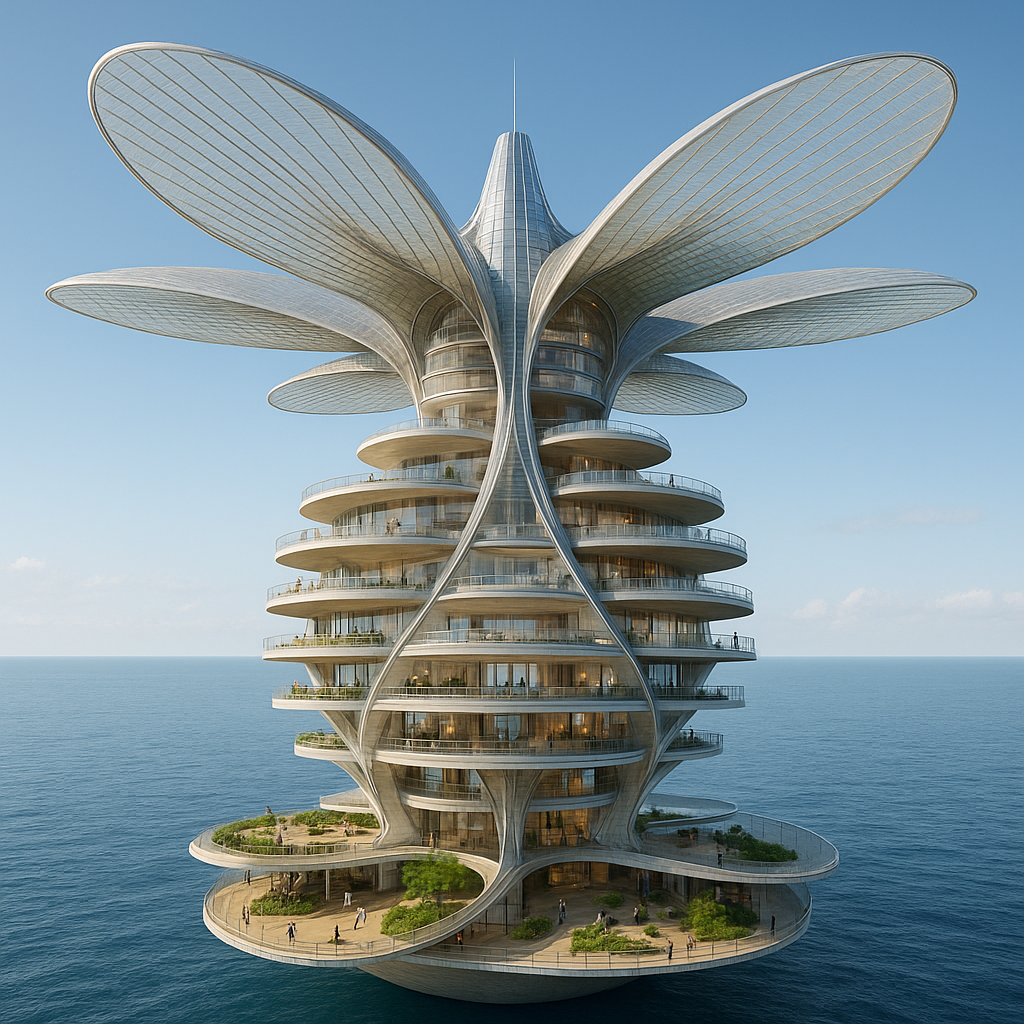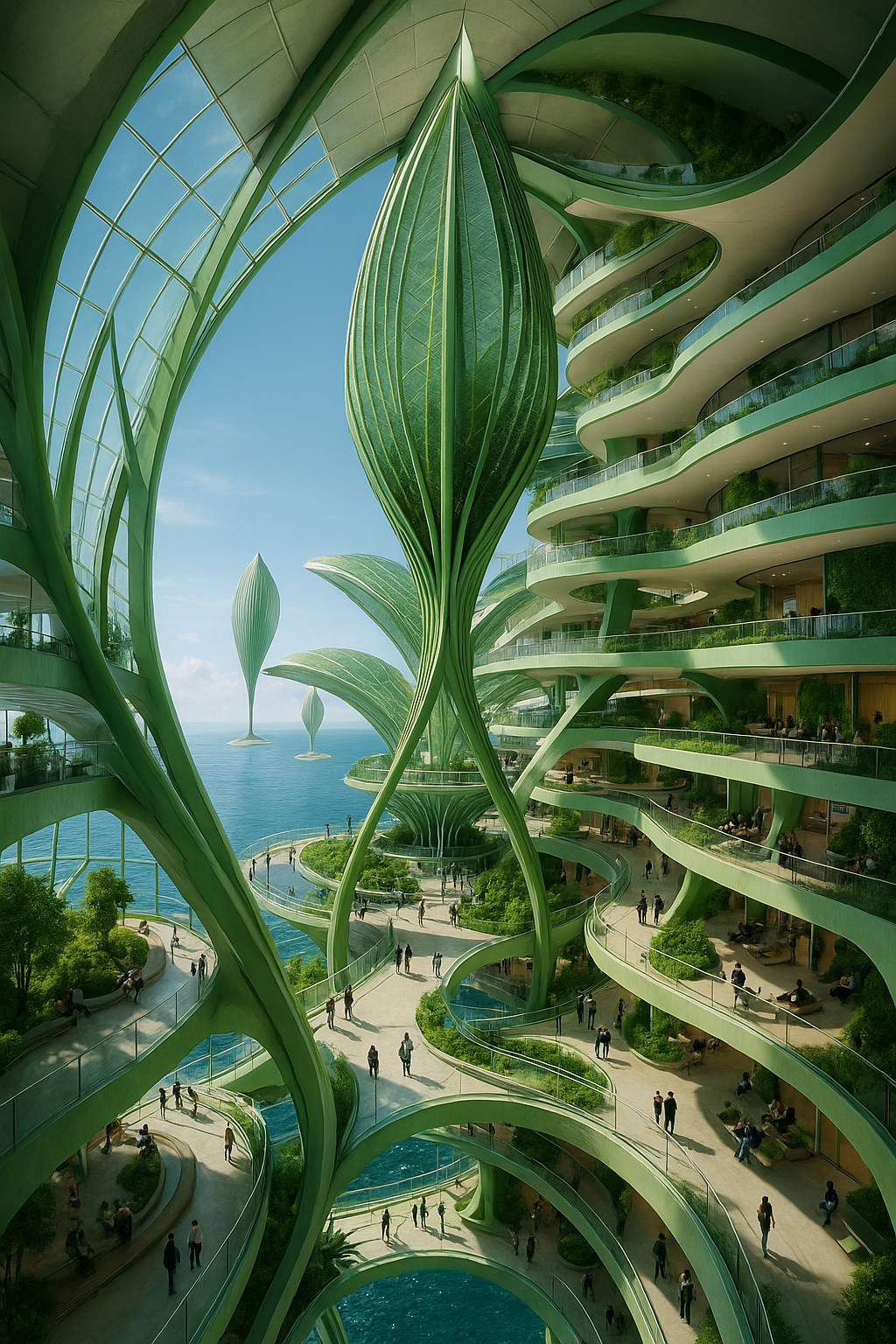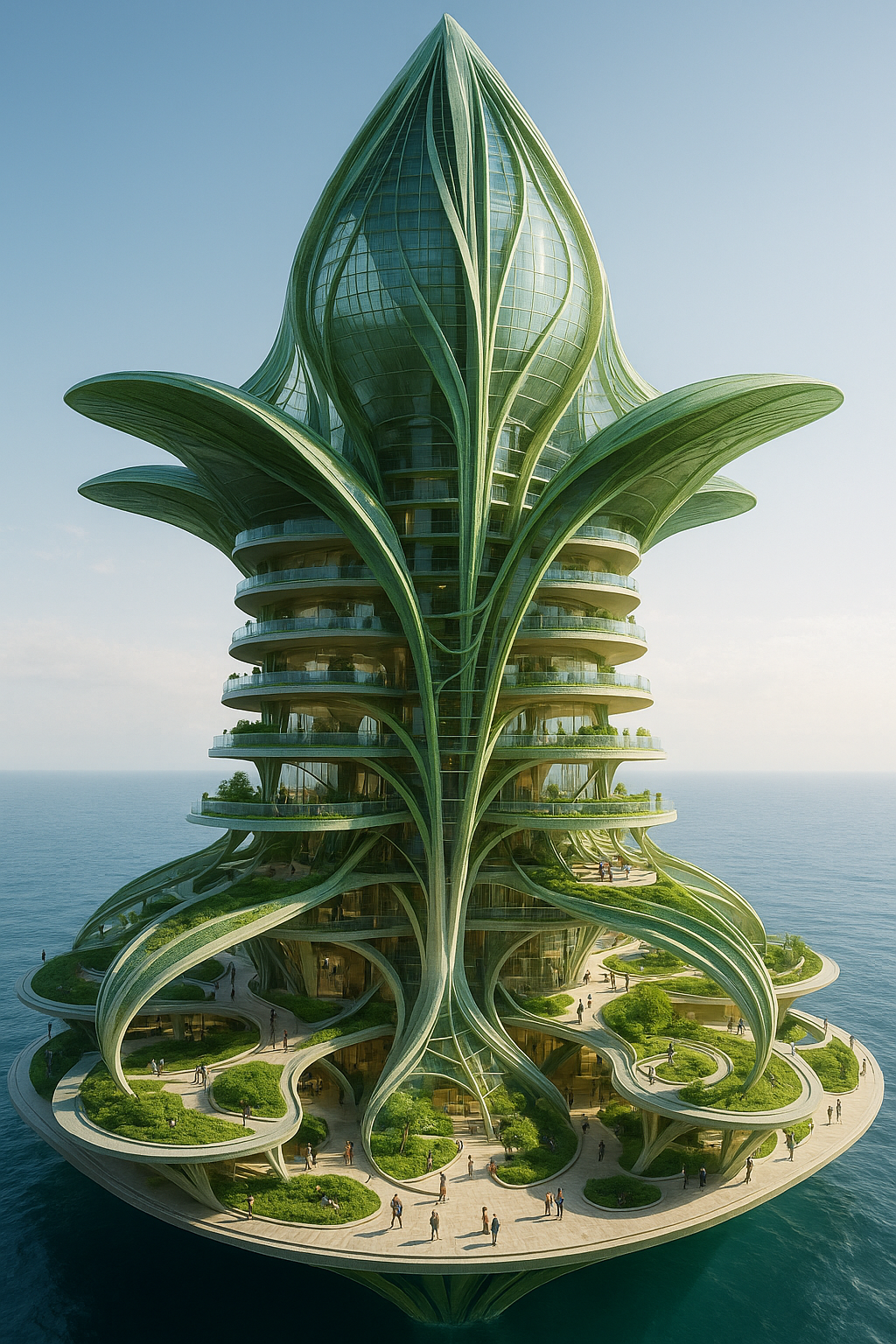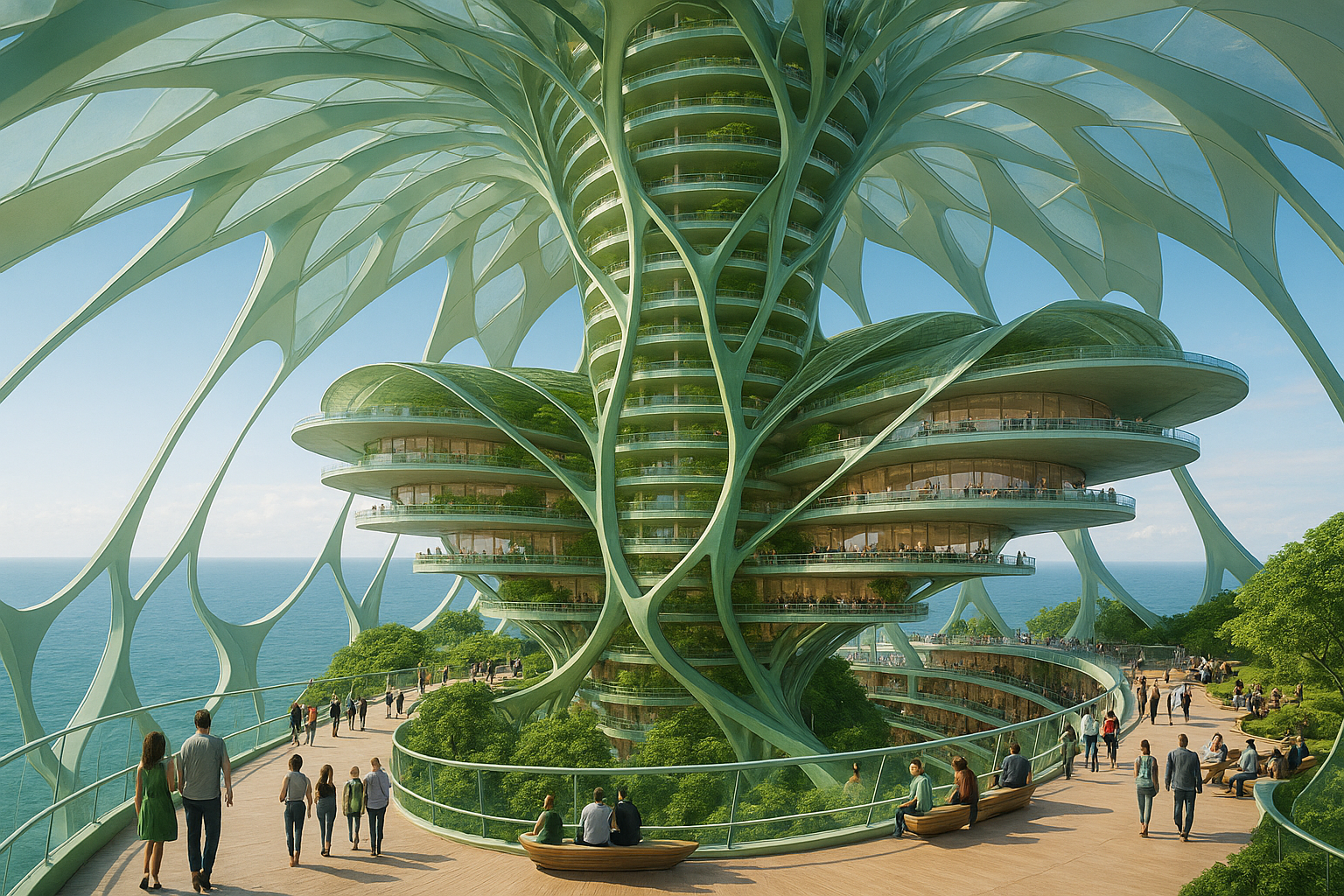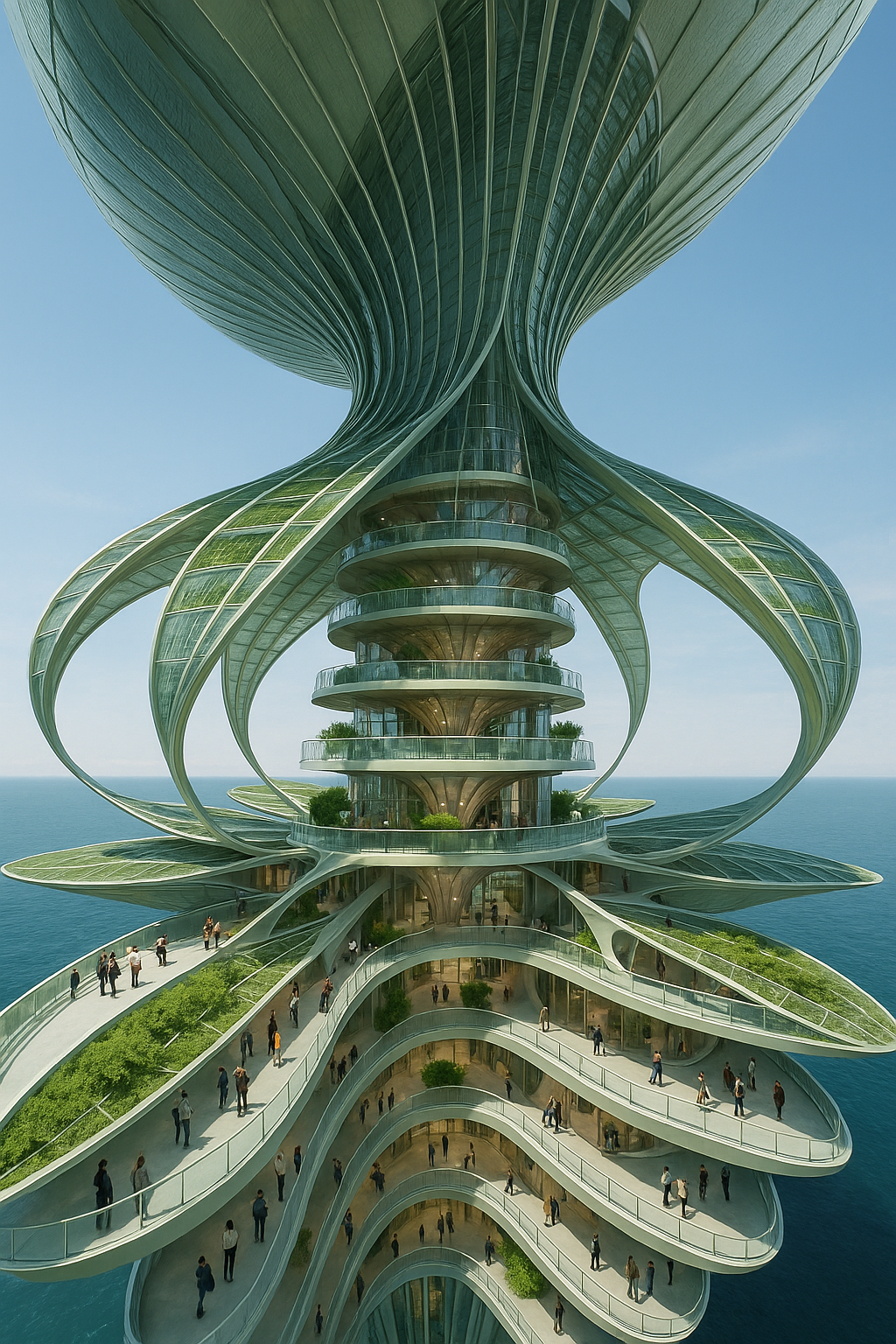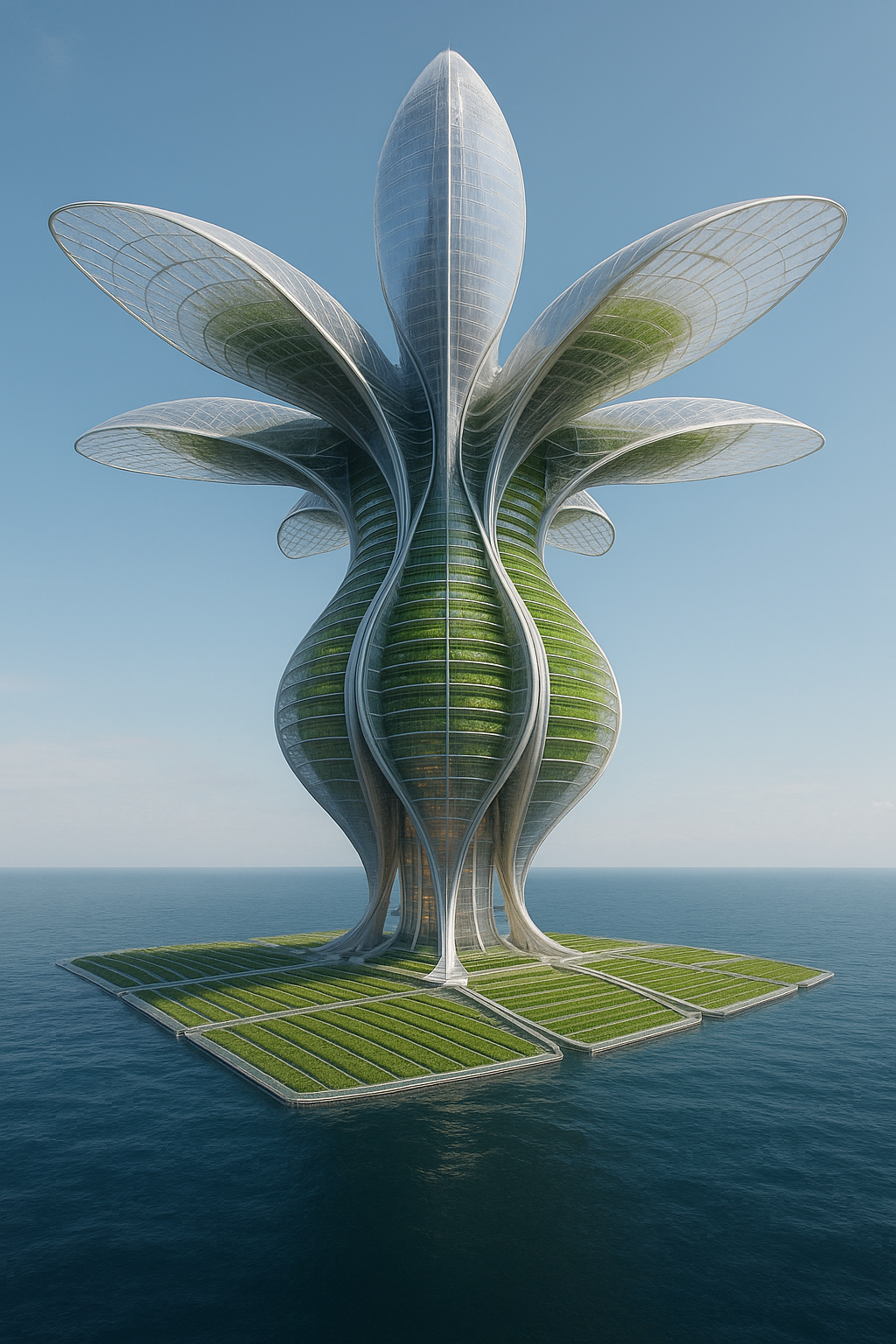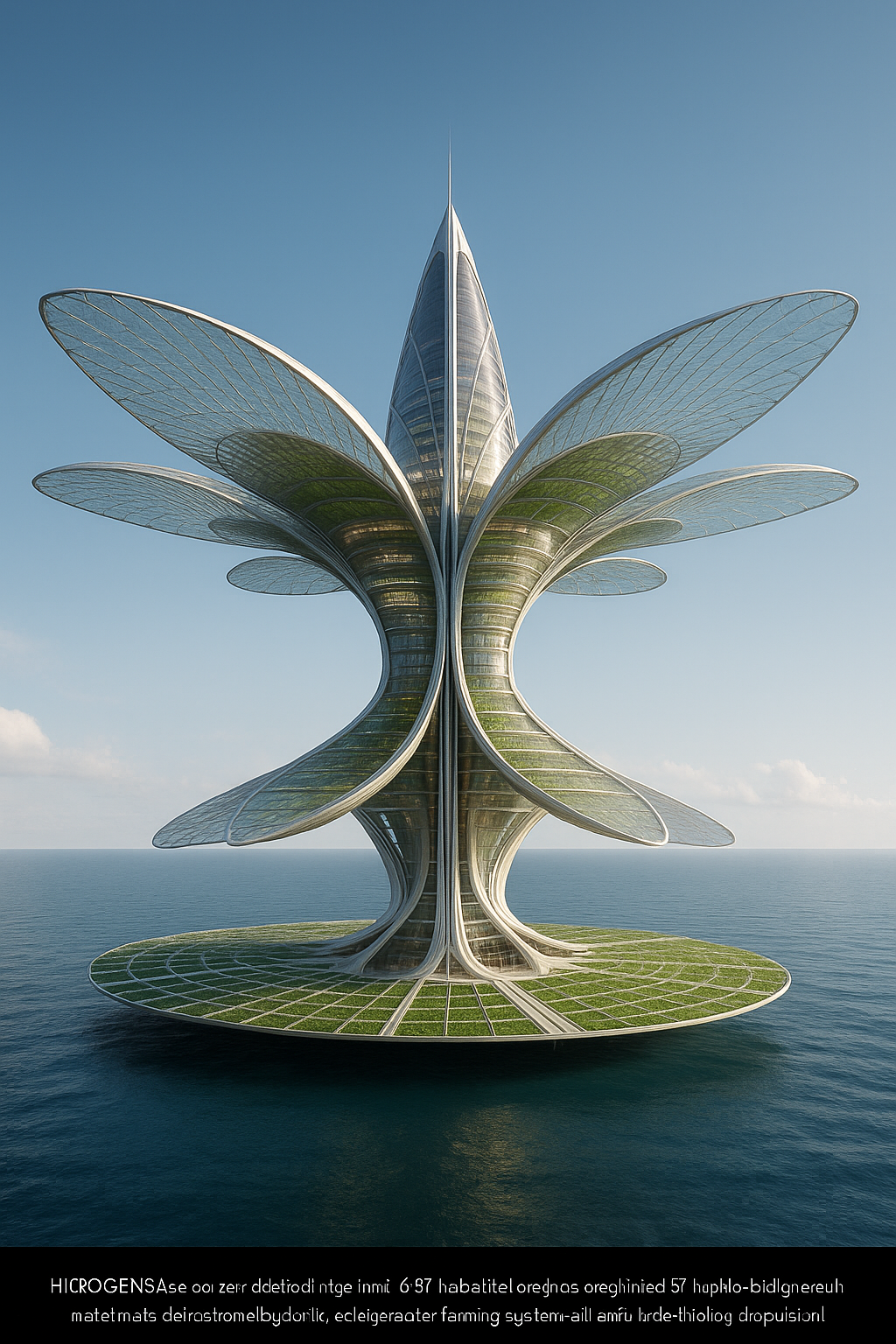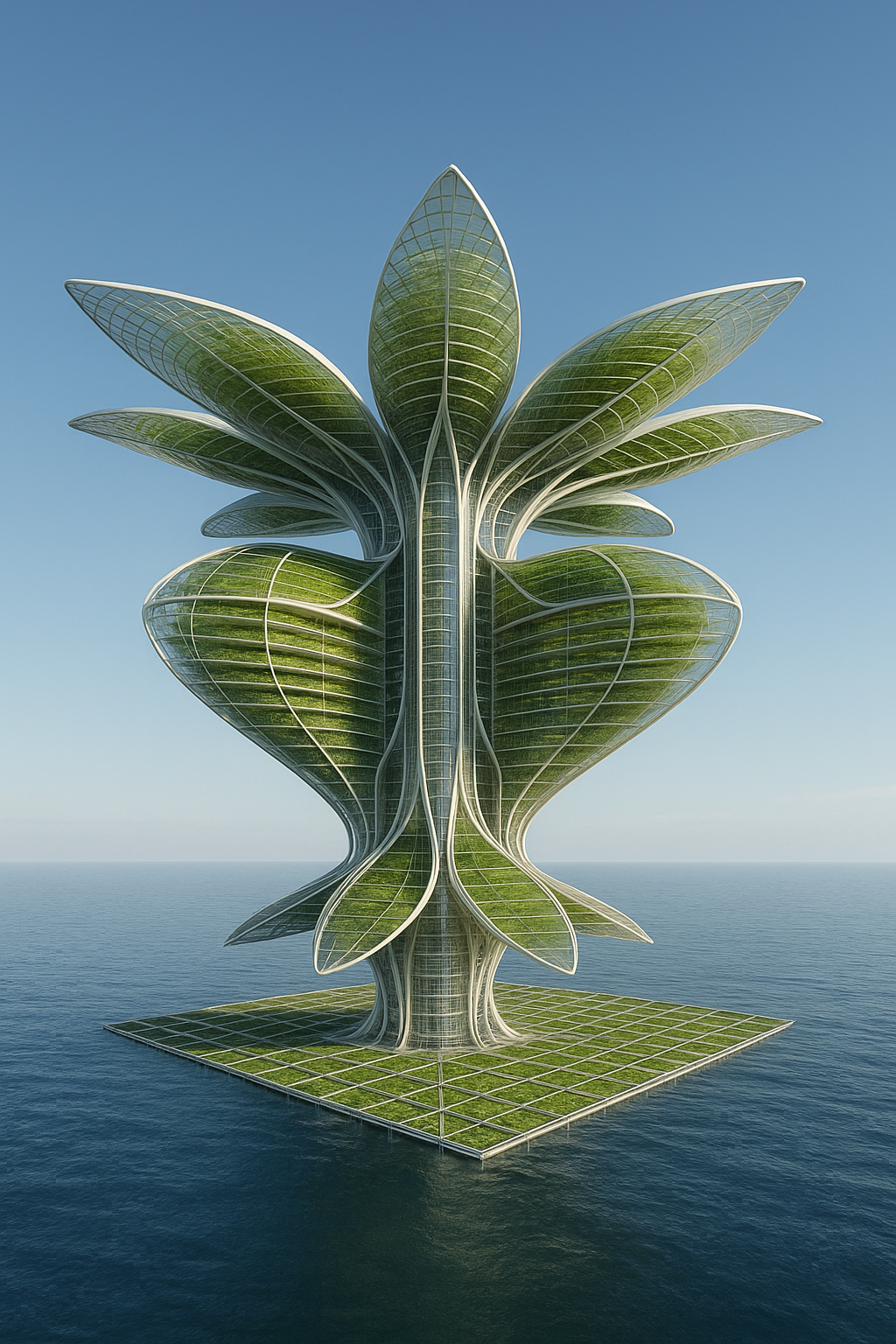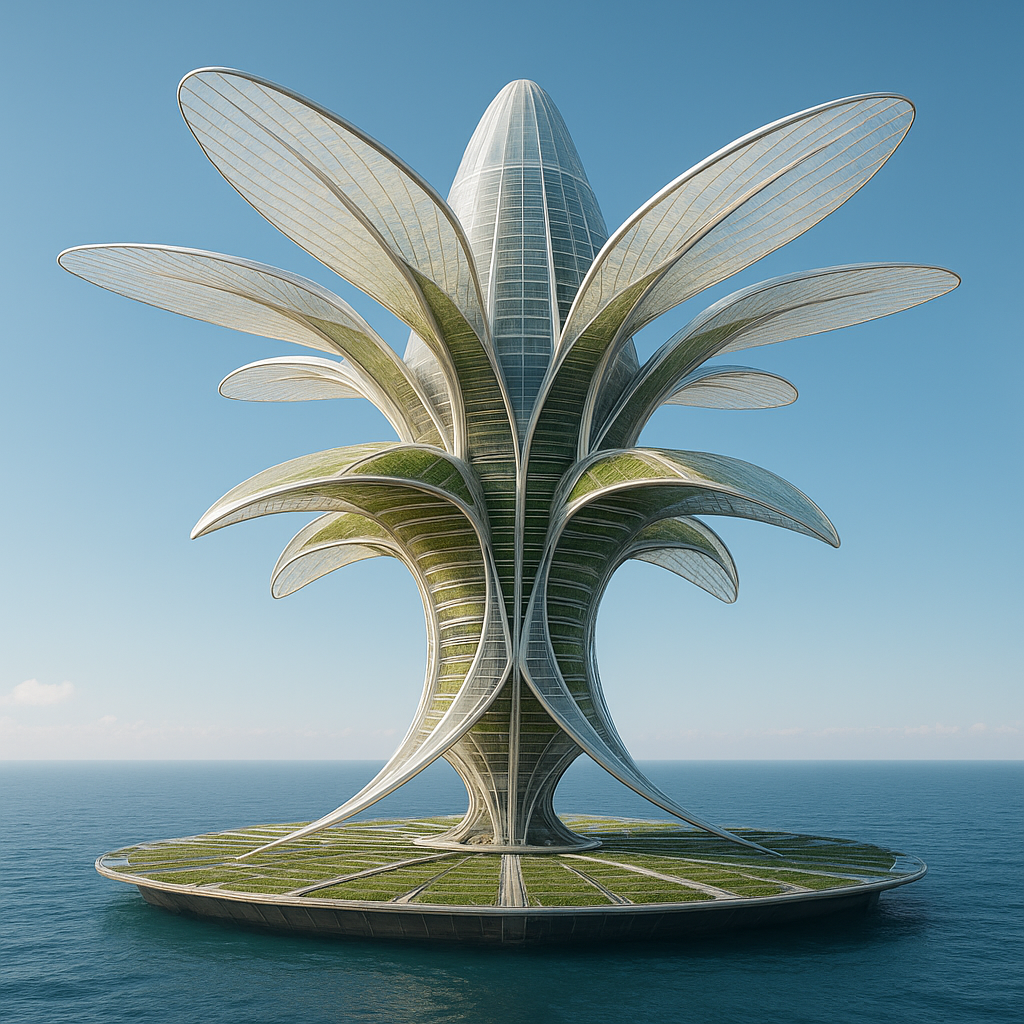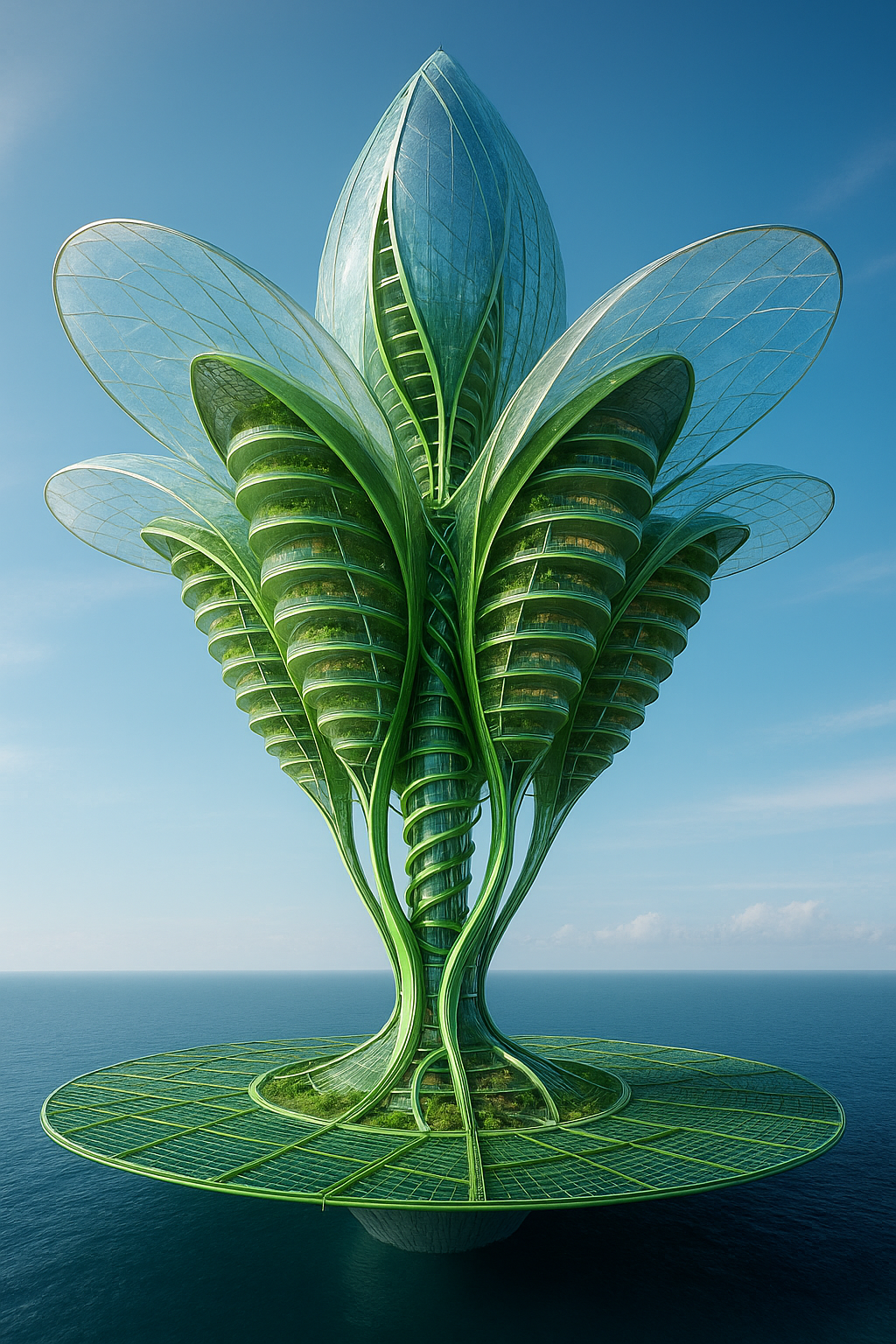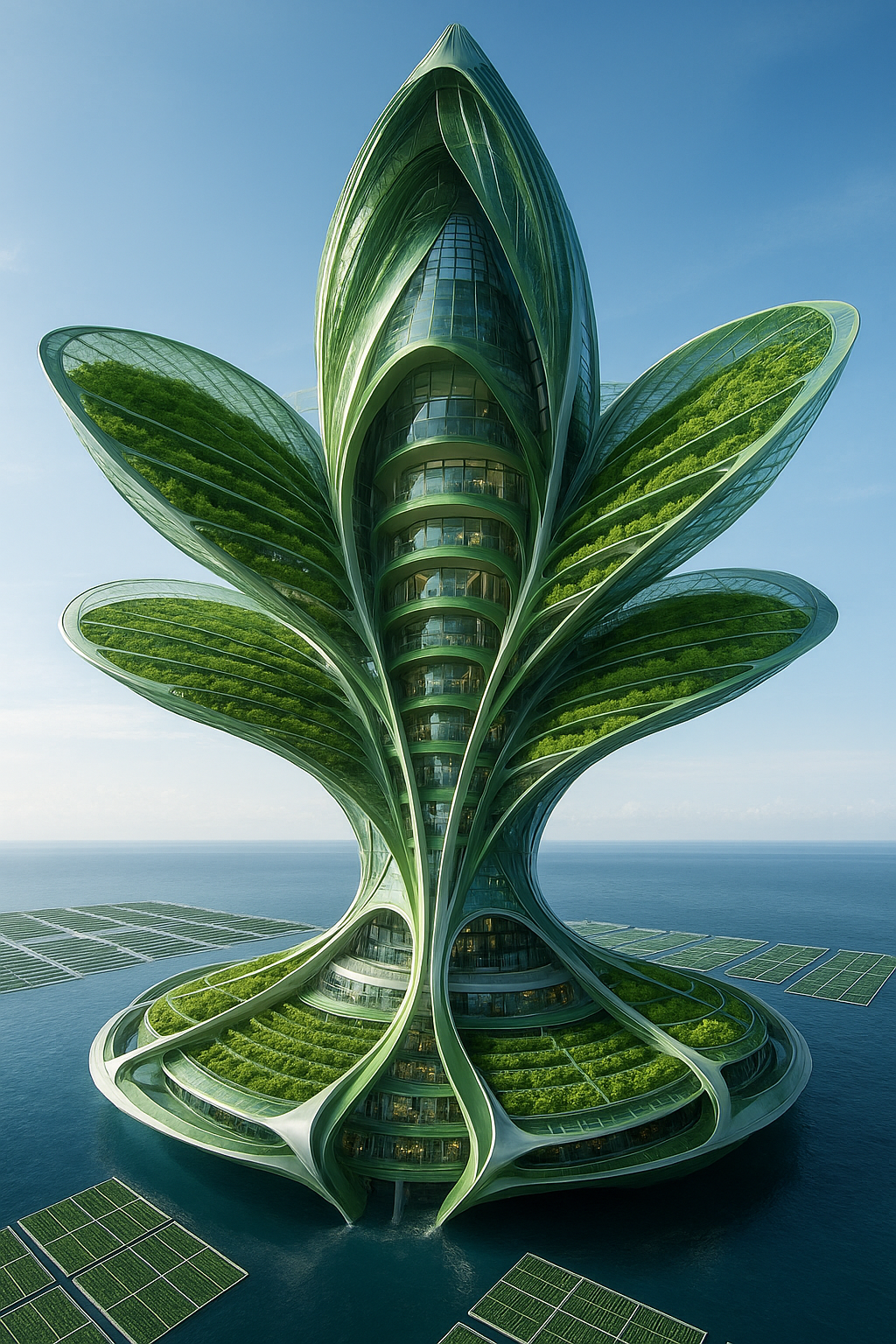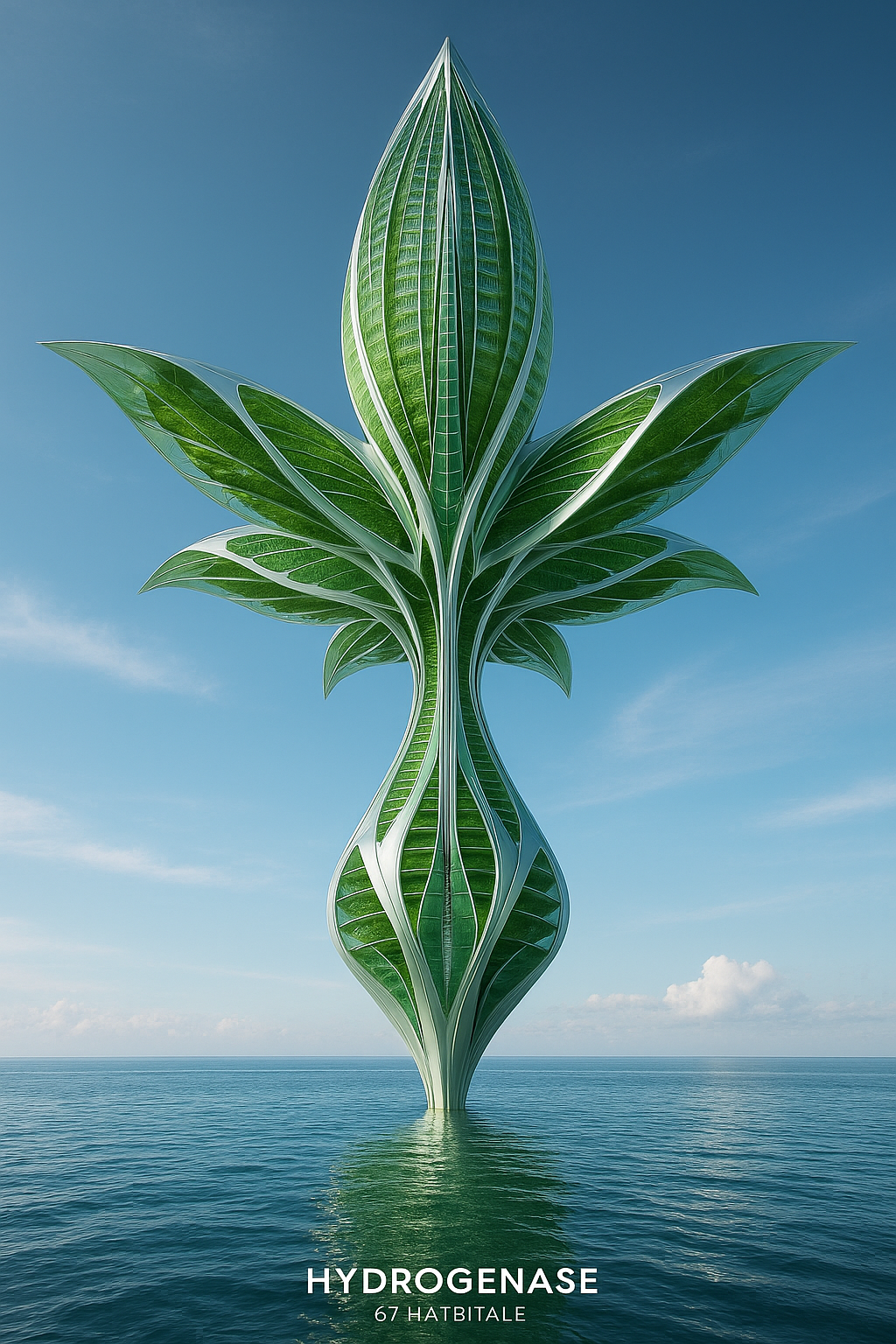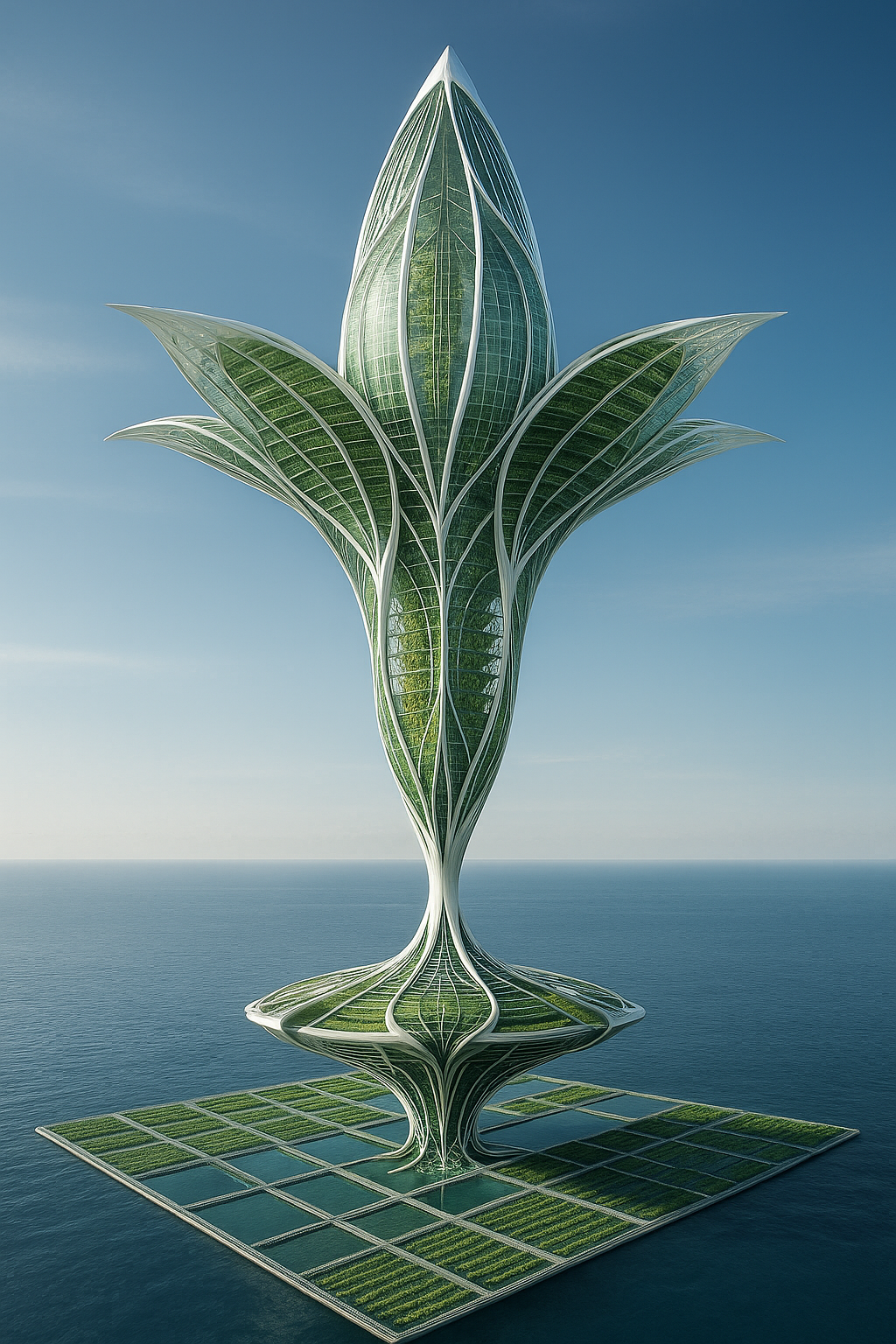Hydrogenase de Vincent Callebaut Architectures
Principais características
Prompt positivo: Ultra-realistic 8K architectural visualization, eye-level perspective of Hydrogenase — the visionary vertical city imagined by Vincent Callebaut Architectures in 2010. This groundbreaking concept envisions a zero-carbon, self-sufficient airborne structure capable of producing biofuel from algae, recycling waste, and supporting human habitation while performing humanitarian missions and ecological surveillance.
Hydrogenase is a flying biomimetic airship — a monumental, organically shaped vessel hovering above the sea, designed not only for aerial mobility but also as a floating habitat and energy generator. Its soft, aerodynamic form is composed of ultra-lightweight biopolymer membranes and semi-transparent solar skins, pulsating with green technologies and suspended over a vast marine landscape.
Integrated within the structure are programs for humanitarian transport, aerial journalism, environmental monitoring, and hospitality services. Inside, living quarters and workspaces are designed with modular efficiency and eco-conscious materials, creating an environment suitable for long-duration missions. Beneath the dirigible, an expansive floating algae farm stretches across the water — a semi-submerged platform harvesting seaweed and microalgae to generate biohydrogen, the primary fuel source of the Hydrogenase system.
The design seeks to heal the ecological scars caused by ground-based infrastructure by minimizing land consumption and replacing rigid networks with adaptable aerial mobility. Rendered under clear, high-contrast daylight with hyper-detailed textures — including organic hull patterns, photovoltaic layering, algae cultivation grids, turbine systems, and reflective aquatic surfaces — the image evokes a fusion of natural systems and advanced ecological engineering.
Inspired by biomimicry, ecological autonomy, and climate-responsive design, Hydrogenase appears as a living organism in flight — a symbiotic fusion of airship and ecosystem, healing landscapes while generating clean energy and fostering planetary resilience.
Prompt negativo: low resolution, heavy industrial shapes, dystopian airships, cluttered background, generic sci-fi design, lack of organic form, empty sea, poor lighting, flat surfaces, unrealistic mechanical details.
Imagens produzidas pelo Chat GPT a partir de entradas de texto
Características formais
Prompt positivo: Ultra-realistic 8K architectural visualization, eye-level perspective of Hydrogenase — the visionary vertical city imagined by Vincent Callebaut Architectures in 2010. Hovering above the ocean, Hydrogenase emerges as a floating biomimetic megastructure shaped like a blossoming flower, with four expansive wings arranged in a petal-like cross formation. Its formal language is defined by repetition and organic symmetry, with each flying unit echoing the same structural motif, creating a visual rhythm in the sky.
Standing 400 meters tall, the vertical structure is engineered for lightness and aerodynamic performance. It is constructed from ultra-lightweight and high-strength materials: carbon fiber, fiberglass, and an advanced nano-structured glass, offering transparency, structural integrity, and reduced weight. The exterior skin features a bionic self-cleaning coating with antibacterial resistance — a sophisticated envelope that enhances hygiene, maintenance, and environmental adaptability.
The core of Hydrogenase is vertically stacked and highly modular, surrounded by aerodynamic “petals” that house functional zones for habitation, research, transportation, and algae-based energy production. The entire system floats but docks onto a mobile oceanic platform, which can reposition itself to different locations across global waters, acting as a regenerative base of operations.
Rendered in high-contrast daylight with hyper-detailed textures — nano-glass panels, tensioned carbon composite ribs, luminous semi-transparent membranes, and crystalline surfaces reflecting ocean light — the scene captures the luminous fragility and futuristic poise of this airborne ecosystem. The sky is clean, the ocean expansive, and the airship glows with ecological intelligence.
Inspired by floral biomimicry, carbon-neutral engineering, and mobile urbanism, Hydrogenase is portrayed as a living airborne sanctuary — a regenerative city in flight, harmonizing technological innovation with natural forms and planetary healing.
Prompt negativo: low resolution, fantasy or sci-fi architecture, asymmetry, decayed or dirty materials, futuristic buildings, modernist glass towers, chaotic composition, surreal lighting, post-apocalyptic aesthetics.
Imagens produzidas pelo Chat GPT a partir de entradas de texto
Características de Infraestrutura de Mobilidade
Prompt positivo: Ultra-realistic 8K architectural visualization, eye-level perspective of Hydrogenase — the visionary vertical city imagined by Vincent Callebaut Architectures in 2010. Designed as a habitable airship with a biomimetic form, Hydrogenase floats gracefully above the ocean, a zero-carbon vertical dirigible that merges clean mobility, architecture, and ecological systems into a single soaring organism.
Its structure resembles a giant flower preparing to bloom, with petal-shaped volumes radiating outward from a central core. Circulation occurs through tall, stem-like conduits that spiral around and between the petals — enabling efficient vertical movement and interconnection between functional zones. These central “stems” house vertical mobility systems, energy conduits, and logistical networks, integrating structure and movement in a seamless flow.
The Hydrogenase hovers at an average altitude of 200 meters and can travel at speeds up to 175 km/h while carrying full operational loads. Its clean propulsion system is powered by biohydrogen derived from cultivated algae, ensuring silent, carbon-neutral navigation. Constructed from carbon fiber, fiberglass, and nano-structured glass with bionic self-cleaning coatings, the airship balances strength and weightlessness with aesthetic elegance.
The structure itself is mobile yet can dock with floating oceanic platforms when needed. Rendered under bright, crystalline daylight with hyper-detailed surfaces — petal membranes glistening with solar energy, translucent nano-glass glowing softly, composite structural ribs, and polished aerodynamic stems — the image captures a technologically advanced airborne sanctuary, alive with motion and light.
This is Hydrogenase as a living vertical airship — a mobile ecosystem soaring gently over the sea, guided by biomimicry, renewable energy, and regenerative design thinking.
Prompt negativo: low resolution, static airships, bulky shapes, non-organic forms, dark or cluttered lighting, noisy propulsion systems, unrealistic materials, lack of circulation clarity, dystopian sci-fi, untextured surfaces.
Imagens produzidas pelo Chat GPT a partir de entradas de texto
Características dos Espaços Verdes
Prompt positivo: Ultra-realistic 8K architectural visualization, eye-level perspective of Hydrogenase — the visionary vertical city conceived by Vincent Callebaut Architectures in 2010. Floating above the ocean like a blossoming aerial organism, Hydrogenase is a zero-carbon, self-sustaining airship designed to merge mobility, habitation, and ecological productivity in a single vertical structure.
The architecture features eight integrated agricultural fields arranged around the vertical core, each functioning as a high-efficiency food and energy production zone. These vertical farms are dedicated to hydroponics, aeroponics, and regenerative agriculture, visually layered like petals along the towering form. At its oceanic base, a large floating algae farm spreads across the water — a living platform cultivating marine algae specifically for biofuel production. This system supplies Hydrogenase with clean biohydrogen, enabling sustainable, emission-free flight.
Constructed from ultra-light materials such as carbon fiber, fiberglass, and nano-structured self-cleaning glass, the structure blends strength with aerial lightness. The petal-like extensions shimmer with photovoltaic membranes and vertical gardens, while translucent growing chambers pulse with life and light.
Rendered in crisp, ambient daylight with hyper-detailed textures — algae bioreactors, agricultural terraces, floating cultivation platforms, and biomimetic aerodynamic surfaces — the image portrays a futuristic farming airship as both architecture and ecosystem. The sky is clear, the ocean reflective, and the atmosphere alive with sustainable intent.
Hydrogenase stands as a mobile, regenerative habitat — a beacon of post-carbon innovation where vertical agriculture and marine ecology fuel a new era of clean, airborne urbanism.
Prompt negativo: low resolution, flat forms, unrealistic agriculture, generic sci-fi, mechanical aesthetics, heavy structure, dark lighting, lack of vegetation, static designs, incoherent circulation.
Imagens produzidas pelo Chat GPT a partir de entradas de texto
Características Espaciais e Funcionais
Prompt positivo: Ultra-realistic 8K architectural visualization, eye-level perspective of Hydrogenase — the visionary vertical city conceived by Vincent Callebaut Architectures in 2010. Suspended gracefully over the ocean, Hydrogenase is a zero-carbon, self-sustaining airship designed to redefine how we inhabit space through clean mobility, regenerative architecture, and ecological integration.
The vertical structure houses 67 habitable floors, each dedicated to a specific program within a continuous and biomimetic megastructure. Its layered interior accommodates activity sectors including residential units, co-living quarters, office spaces, ecological research laboratories, and open entertainment areas. Designed for adaptability and resilience, Hydrogenase proposes a sustainable alternative to conventional modes of urban living — transforming airborne architecture into a new model of vertical, nomadic habitat.
The dirigible also serves as a platform for eco-tourism and aerial leisure experiences, featuring observation decks, floating gardens, amphitheaters, and interactive learning spaces that open directly onto translucent skybridges and petal-like wings. The entire structure is engineered from ultralight carbon fiber, fiberglass, and self-cleaning nano-glass — allowing it to hover with aerodynamic elegance while supporting its multifunctional program.
Rendered under crystal-clear daylight with hyper-detailed textures — including curved transparent facades, tensioned composite ribs, solar-reactive membranes, and shaded terraces — the image captures the interior vitality and structural refinement of this airborne sanctuary. The atmosphere is vibrant yet serene, a confluence of science, ecology, and design innovation.
Hydrogenase is portrayed as a soaring vertical habitat — a regenerative airship that embodies a future of climate-resilient living, mobile architecture, and symbiotic human-environment interaction.
Prompt negativo: low resolution, generic airship design, lack of spatial programming, dark interiors, mechanical clutter, heavy structure, sci-fi dystopia, empty façades, unrealistic materials, poor lighting.
Imagens produzidas pelo Chat GPT a partir de entradas de texto
Todos os prompts anteriores.
Prompt positivo: Ultra-realistic 8K architectural visualization, eye-level perspective of Hydrogenase — the visionary vertical city imagined by Vincent Callebaut Architectures in 2010. Suspended above the ocean like a blooming aerial organism, Hydrogenase is a self-sufficient, zero-carbon airship designed to redefine urban life through clean mobility, ecological architecture, and regenerative systems.
The structure reaches 400 meters in height and features 67 habitable floors, organized into zones for residential units, co-living spaces, ecological research labs, offices, scientific facilities, entertainment decks, and aerial leisure areas. The overall form is inspired by floral biomimicry — four expansive, petal-like wings arranged in a cross formation, radiating from a central vertical core. Movement within the structure flows through tall stem-like conduits, housing vertical circulation, logistics, and energy systems.
Eight high-efficiency agricultural fields are vertically integrated into the petal structures, including hydroponic, aeroponic, and regenerative farming systems. Below the dirigible, a vast floating algae farm stretches across the sea — a semi-submerged bioreactor platform producing clean biohydrogen that powers Hydrogenase’s silent, emission-free propulsion system. The airship cruises at an average altitude of 200 meters and can travel at speeds up to 175 km/h while carrying full operational loads.
Crafted from ultralight, high-performance materials — carbon fiber, fiberglass, and advanced nano-structured glass — the structure features self-cleaning, bionic coatings that prevent bacterial adhesion and reduce maintenance. The petals are covered in translucent photovoltaic membranes, shimmering in natural light, while the internal architecture offers modular, sustainable environments for long-term inhabitation and humanitarian missions.
Rendered in clear, high-contrast daylight, the image reveals hyper-detailed textures: crystalline solar skins, composite carbon ribs, illuminated bio-glass membranes, algae cultivation grids, and reflective marine surfaces. The Hydrogenase hovers in serene equilibrium — a glowing vertical airship ecosystem framed by vast oceanic horizons.
Guided by biomimicry, climate sensitivity, and post-carbon innovation, Hydrogenase is portrayed as a living dirigible — a regenerative city in motion that heals landscapes, generates clean energy, and fosters a symbiotic relationship between humans and Earth’s atmospheric and marine systems.
Prompt negativo: low resolution, sci-fi dystopia, flat design, heavy or bulky forms, dark lighting, cluttered composition, mechanical aesthetics, unrealistic materials, empty agricultural zones, incoherent structure.
Imagens produzidas pelo Chat GPT a partir de entradas de texto
